Risk Analysis of Commonwealth Bank of Australia
VerifiedAdded on 2023/01/11
|22
|4173
|47
AI Summary
This study analyzes the risk and return of Commonwealth Bank of Australia to recommend investment based on the company's development and growth.
Contribute Materials
Your contribution can guide someone’s learning journey. Share your
documents today.
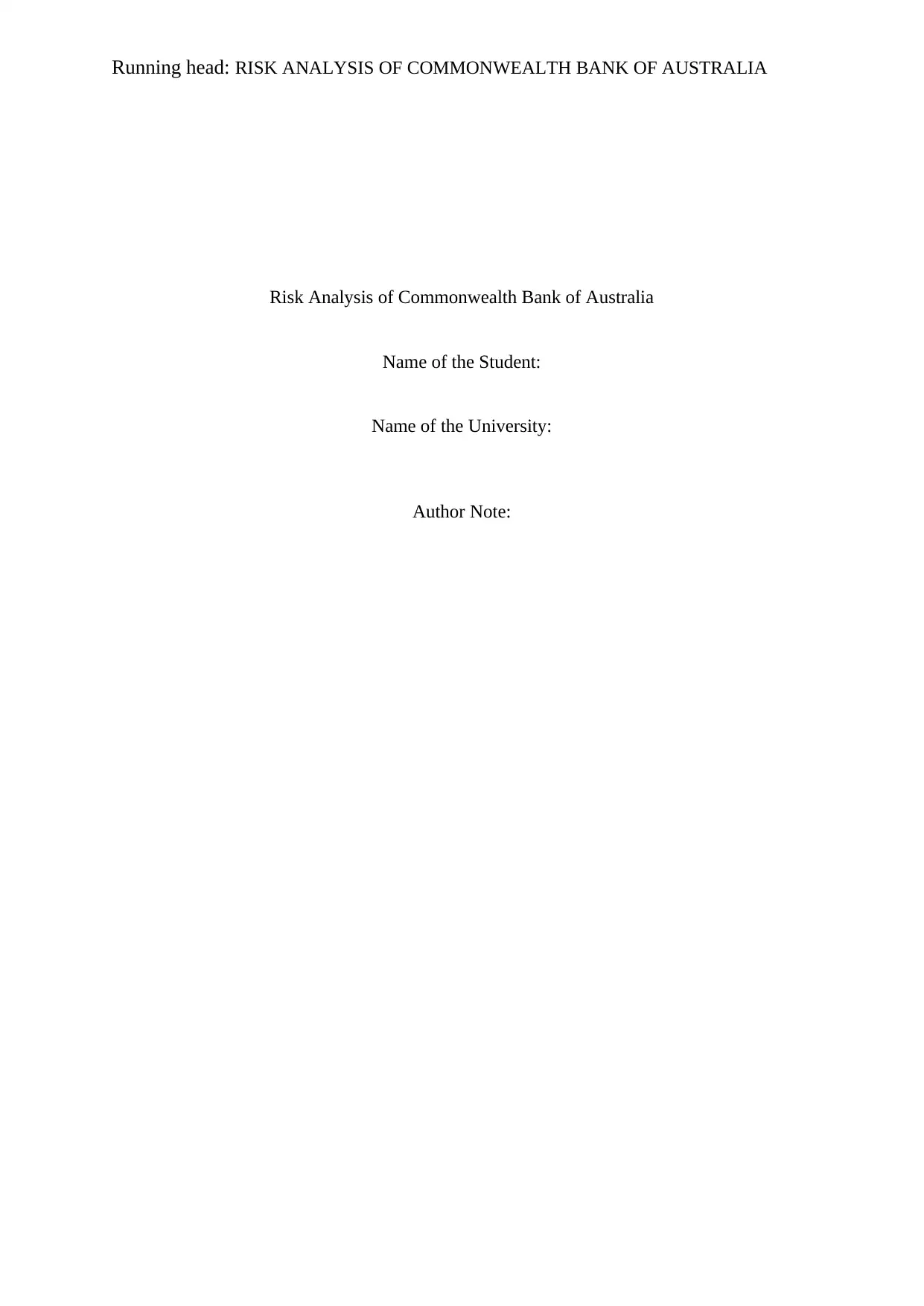
Running head: RISK ANALYSIS OF COMMONWEALTH BANK OF AUSTRALIA
Risk Analysis of Commonwealth Bank of Australia
Name of the Student:
Name of the University:
Author Note:
Risk Analysis of Commonwealth Bank of Australia
Name of the Student:
Name of the University:
Author Note:
Secure Best Marks with AI Grader
Need help grading? Try our AI Grader for instant feedback on your assignments.
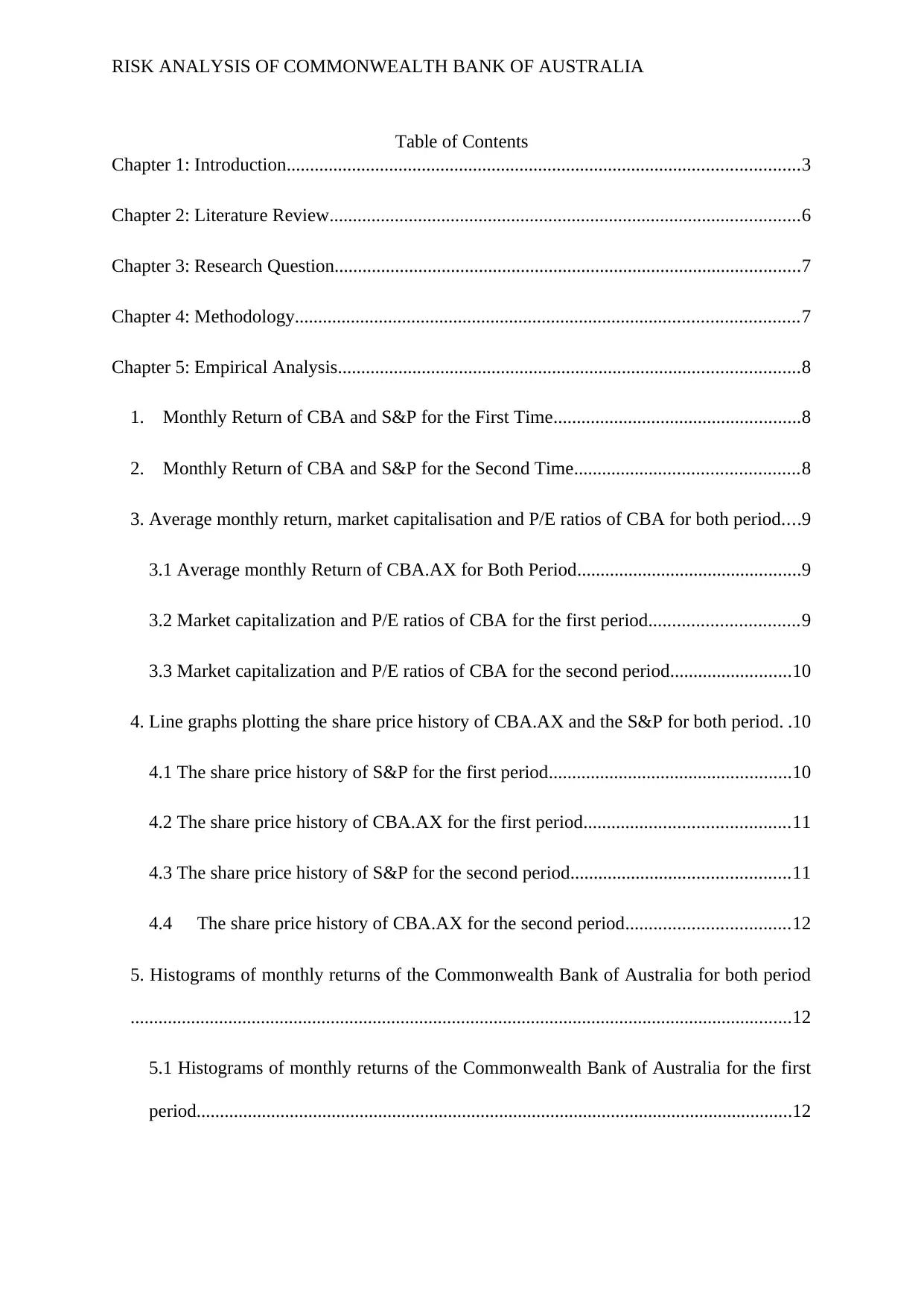
RISK ANALYSIS OF COMMONWEALTH BANK OF AUSTRALIA
Table of Contents
Chapter 1: Introduction..............................................................................................................3
Chapter 2: Literature Review.....................................................................................................6
Chapter 3: Research Question....................................................................................................7
Chapter 4: Methodology............................................................................................................7
Chapter 5: Empirical Analysis...................................................................................................8
1. Monthly Return of CBA and S&P for the First Time.....................................................8
2. Monthly Return of CBA and S&P for the Second Time................................................8
3. Average monthly return, market capitalisation and P/E ratios of CBA for both period....9
3.1 Average monthly Return of CBA.AX for Both Period................................................9
3.2 Market capitalization and P/E ratios of CBA for the first period................................9
3.3 Market capitalization and P/E ratios of CBA for the second period..........................10
4. Line graphs plotting the share price history of CBA.AX and the S&P for both period. .10
4.1 The share price history of S&P for the first period....................................................10
4.2 The share price history of CBA.AX for the first period............................................11
4.3 The share price history of S&P for the second period...............................................11
4.4 The share price history of CBA.AX for the second period...................................12
5. Histograms of monthly returns of the Commonwealth Bank of Australia for both period
..............................................................................................................................................12
5.1 Histograms of monthly returns of the Commonwealth Bank of Australia for the first
period................................................................................................................................12
Table of Contents
Chapter 1: Introduction..............................................................................................................3
Chapter 2: Literature Review.....................................................................................................6
Chapter 3: Research Question....................................................................................................7
Chapter 4: Methodology............................................................................................................7
Chapter 5: Empirical Analysis...................................................................................................8
1. Monthly Return of CBA and S&P for the First Time.....................................................8
2. Monthly Return of CBA and S&P for the Second Time................................................8
3. Average monthly return, market capitalisation and P/E ratios of CBA for both period....9
3.1 Average monthly Return of CBA.AX for Both Period................................................9
3.2 Market capitalization and P/E ratios of CBA for the first period................................9
3.3 Market capitalization and P/E ratios of CBA for the second period..........................10
4. Line graphs plotting the share price history of CBA.AX and the S&P for both period. .10
4.1 The share price history of S&P for the first period....................................................10
4.2 The share price history of CBA.AX for the first period............................................11
4.3 The share price history of S&P for the second period...............................................11
4.4 The share price history of CBA.AX for the second period...................................12
5. Histograms of monthly returns of the Commonwealth Bank of Australia for both period
..............................................................................................................................................12
5.1 Histograms of monthly returns of the Commonwealth Bank of Australia for the first
period................................................................................................................................12
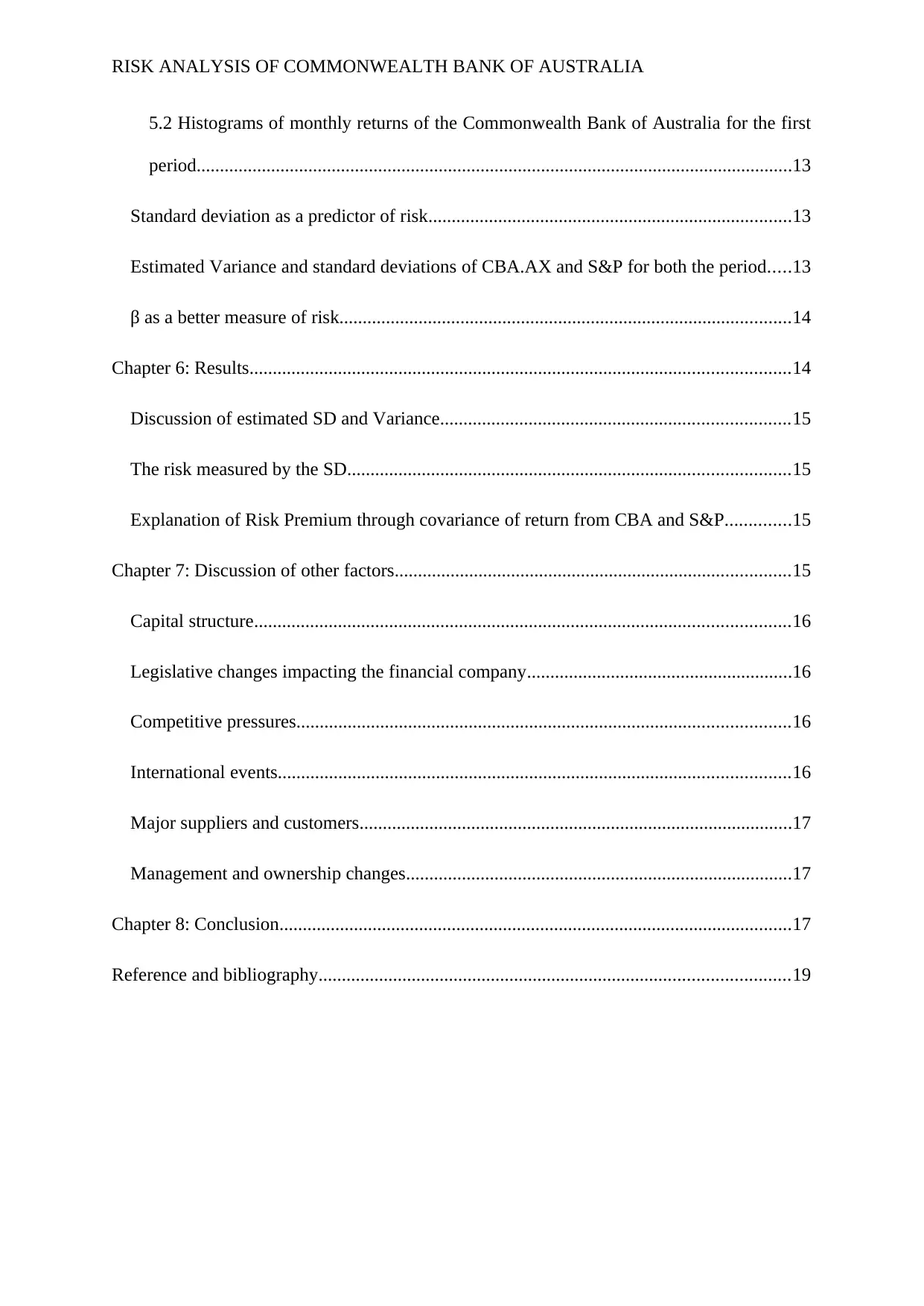
RISK ANALYSIS OF COMMONWEALTH BANK OF AUSTRALIA
5.2 Histograms of monthly returns of the Commonwealth Bank of Australia for the first
period................................................................................................................................13
Standard deviation as a predictor of risk..............................................................................13
Estimated Variance and standard deviations of CBA.AX and S&P for both the period.....13
β as a better measure of risk.................................................................................................14
Chapter 6: Results....................................................................................................................14
Discussion of estimated SD and Variance...........................................................................15
The risk measured by the SD...............................................................................................15
Explanation of Risk Premium through covariance of return from CBA and S&P..............15
Chapter 7: Discussion of other factors.....................................................................................15
Capital structure...................................................................................................................16
Legislative changes impacting the financial company.........................................................16
Competitive pressures..........................................................................................................16
International events..............................................................................................................16
Major suppliers and customers.............................................................................................17
Management and ownership changes...................................................................................17
Chapter 8: Conclusion..............................................................................................................17
Reference and bibliography.....................................................................................................19
5.2 Histograms of monthly returns of the Commonwealth Bank of Australia for the first
period................................................................................................................................13
Standard deviation as a predictor of risk..............................................................................13
Estimated Variance and standard deviations of CBA.AX and S&P for both the period.....13
β as a better measure of risk.................................................................................................14
Chapter 6: Results....................................................................................................................14
Discussion of estimated SD and Variance...........................................................................15
The risk measured by the SD...............................................................................................15
Explanation of Risk Premium through covariance of return from CBA and S&P..............15
Chapter 7: Discussion of other factors.....................................................................................15
Capital structure...................................................................................................................16
Legislative changes impacting the financial company.........................................................16
Competitive pressures..........................................................................................................16
International events..............................................................................................................16
Major suppliers and customers.............................................................................................17
Management and ownership changes...................................................................................17
Chapter 8: Conclusion..............................................................................................................17
Reference and bibliography.....................................................................................................19
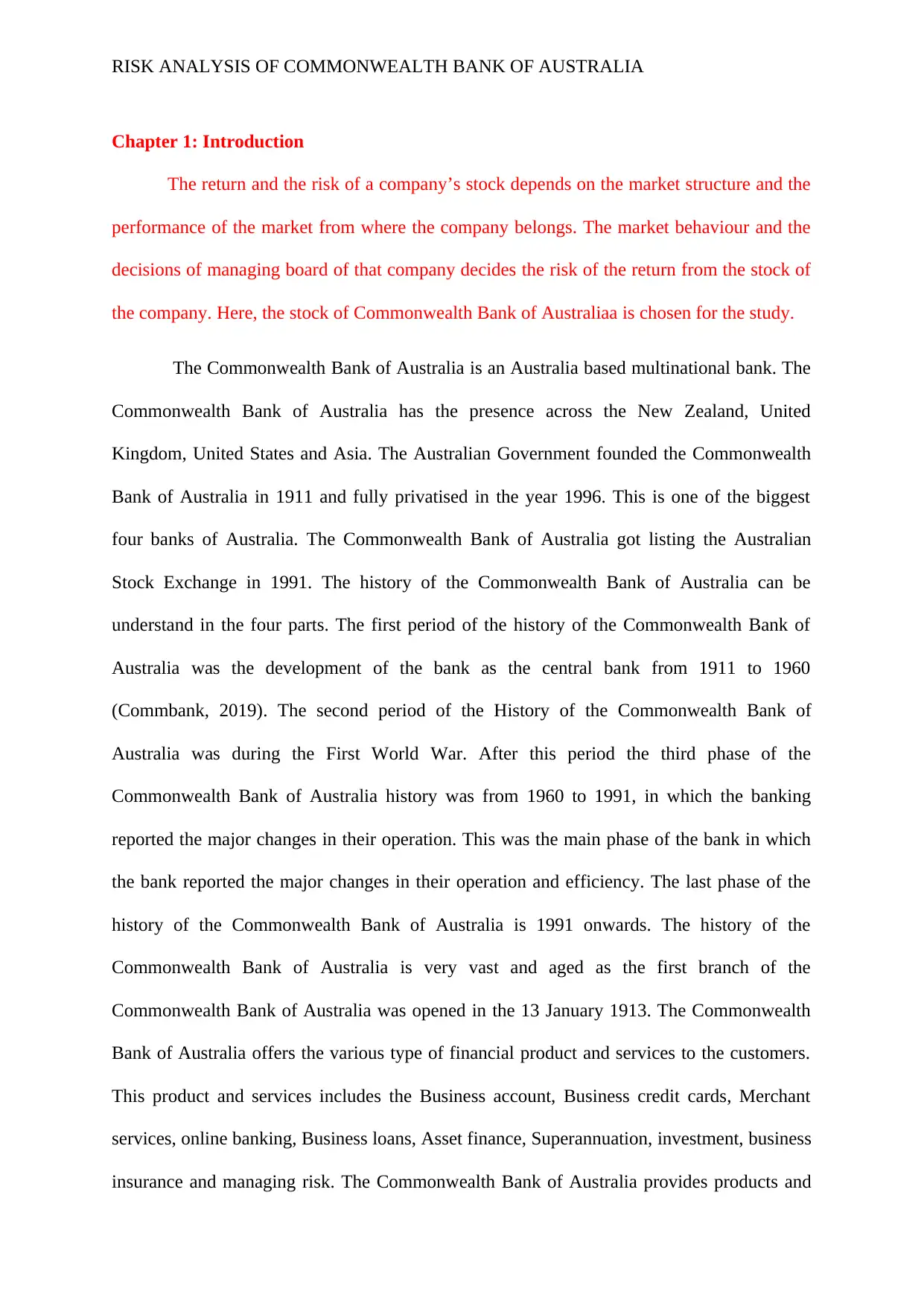
RISK ANALYSIS OF COMMONWEALTH BANK OF AUSTRALIA
Chapter 1: Introduction
The return and the risk of a company’s stock depends on the market structure and the
performance of the market from where the company belongs. The market behaviour and the
decisions of managing board of that company decides the risk of the return from the stock of
the company. Here, the stock of Commonwealth Bank of Australiaa is chosen for the study.
The Commonwealth Bank of Australia is an Australia based multinational bank. The
Commonwealth Bank of Australia has the presence across the New Zealand, United
Kingdom, United States and Asia. The Australian Government founded the Commonwealth
Bank of Australia in 1911 and fully privatised in the year 1996. This is one of the biggest
four banks of Australia. The Commonwealth Bank of Australia got listing the Australian
Stock Exchange in 1991. The history of the Commonwealth Bank of Australia can be
understand in the four parts. The first period of the history of the Commonwealth Bank of
Australia was the development of the bank as the central bank from 1911 to 1960
(Commbank, 2019). The second period of the History of the Commonwealth Bank of
Australia was during the First World War. After this period the third phase of the
Commonwealth Bank of Australia history was from 1960 to 1991, in which the banking
reported the major changes in their operation. This was the main phase of the bank in which
the bank reported the major changes in their operation and efficiency. The last phase of the
history of the Commonwealth Bank of Australia is 1991 onwards. The history of the
Commonwealth Bank of Australia is very vast and aged as the first branch of the
Commonwealth Bank of Australia was opened in the 13 January 1913. The Commonwealth
Bank of Australia offers the various type of financial product and services to the customers.
This product and services includes the Business account, Business credit cards, Merchant
services, online banking, Business loans, Asset finance, Superannuation, investment, business
insurance and managing risk. The Commonwealth Bank of Australia provides products and
Chapter 1: Introduction
The return and the risk of a company’s stock depends on the market structure and the
performance of the market from where the company belongs. The market behaviour and the
decisions of managing board of that company decides the risk of the return from the stock of
the company. Here, the stock of Commonwealth Bank of Australiaa is chosen for the study.
The Commonwealth Bank of Australia is an Australia based multinational bank. The
Commonwealth Bank of Australia has the presence across the New Zealand, United
Kingdom, United States and Asia. The Australian Government founded the Commonwealth
Bank of Australia in 1911 and fully privatised in the year 1996. This is one of the biggest
four banks of Australia. The Commonwealth Bank of Australia got listing the Australian
Stock Exchange in 1991. The history of the Commonwealth Bank of Australia can be
understand in the four parts. The first period of the history of the Commonwealth Bank of
Australia was the development of the bank as the central bank from 1911 to 1960
(Commbank, 2019). The second period of the History of the Commonwealth Bank of
Australia was during the First World War. After this period the third phase of the
Commonwealth Bank of Australia history was from 1960 to 1991, in which the banking
reported the major changes in their operation. This was the main phase of the bank in which
the bank reported the major changes in their operation and efficiency. The last phase of the
history of the Commonwealth Bank of Australia is 1991 onwards. The history of the
Commonwealth Bank of Australia is very vast and aged as the first branch of the
Commonwealth Bank of Australia was opened in the 13 January 1913. The Commonwealth
Bank of Australia offers the various type of financial product and services to the customers.
This product and services includes the Business account, Business credit cards, Merchant
services, online banking, Business loans, Asset finance, Superannuation, investment, business
insurance and managing risk. The Commonwealth Bank of Australia provides products and
Secure Best Marks with AI Grader
Need help grading? Try our AI Grader for instant feedback on your assignments.
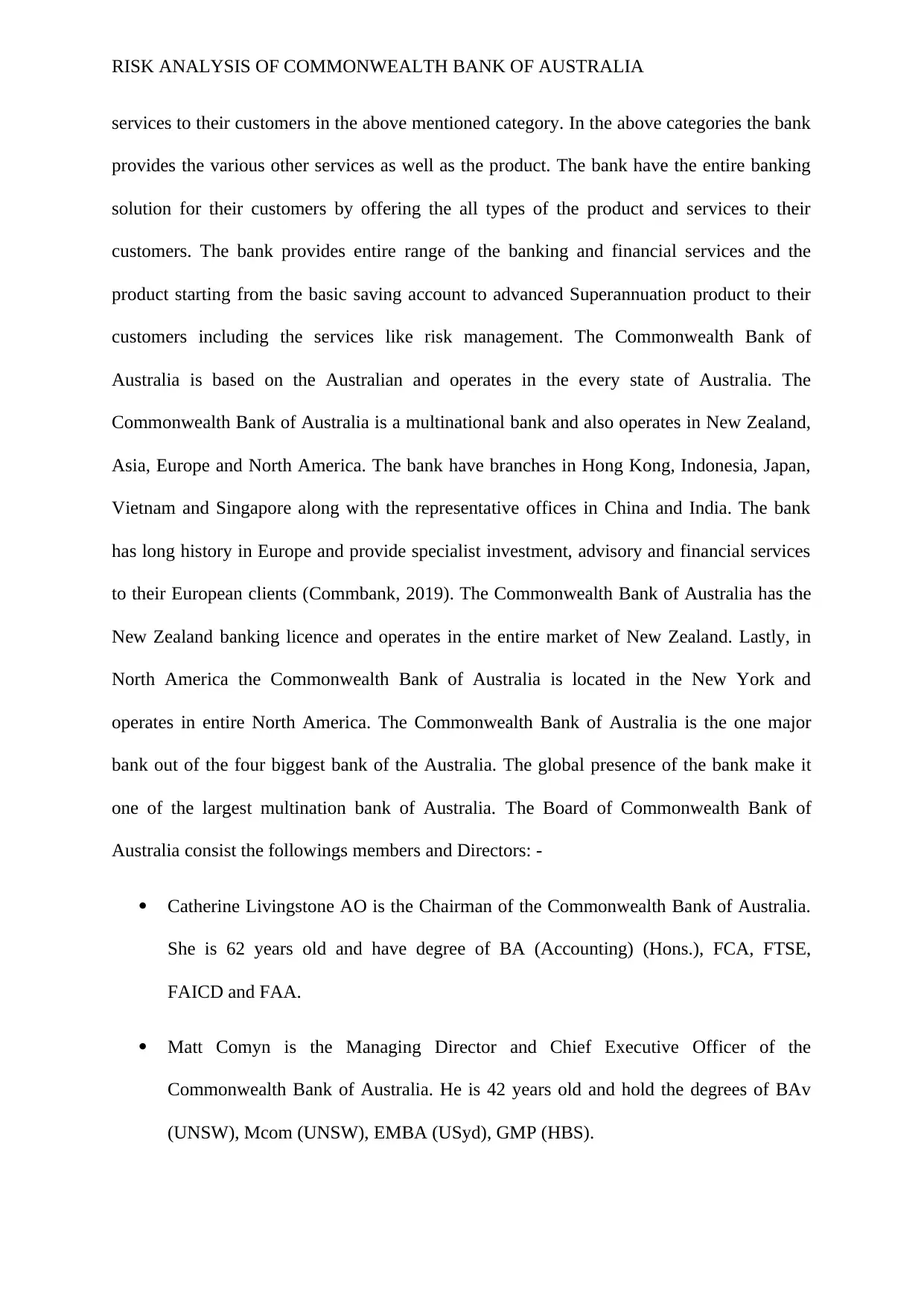
RISK ANALYSIS OF COMMONWEALTH BANK OF AUSTRALIA
services to their customers in the above mentioned category. In the above categories the bank
provides the various other services as well as the product. The bank have the entire banking
solution for their customers by offering the all types of the product and services to their
customers. The bank provides entire range of the banking and financial services and the
product starting from the basic saving account to advanced Superannuation product to their
customers including the services like risk management. The Commonwealth Bank of
Australia is based on the Australian and operates in the every state of Australia. The
Commonwealth Bank of Australia is a multinational bank and also operates in New Zealand,
Asia, Europe and North America. The bank have branches in Hong Kong, Indonesia, Japan,
Vietnam and Singapore along with the representative offices in China and India. The bank
has long history in Europe and provide specialist investment, advisory and financial services
to their European clients (Commbank, 2019). The Commonwealth Bank of Australia has the
New Zealand banking licence and operates in the entire market of New Zealand. Lastly, in
North America the Commonwealth Bank of Australia is located in the New York and
operates in entire North America. The Commonwealth Bank of Australia is the one major
bank out of the four biggest bank of the Australia. The global presence of the bank make it
one of the largest multination bank of Australia. The Board of Commonwealth Bank of
Australia consist the followings members and Directors: -
Catherine Livingstone AO is the Chairman of the Commonwealth Bank of Australia.
She is 62 years old and have degree of BA (Accounting) (Hons.), FCA, FTSE,
FAICD and FAA.
Matt Comyn is the Managing Director and Chief Executive Officer of the
Commonwealth Bank of Australia. He is 42 years old and hold the degrees of BAv
(UNSW), Mcom (UNSW), EMBA (USyd), GMP (HBS).
services to their customers in the above mentioned category. In the above categories the bank
provides the various other services as well as the product. The bank have the entire banking
solution for their customers by offering the all types of the product and services to their
customers. The bank provides entire range of the banking and financial services and the
product starting from the basic saving account to advanced Superannuation product to their
customers including the services like risk management. The Commonwealth Bank of
Australia is based on the Australian and operates in the every state of Australia. The
Commonwealth Bank of Australia is a multinational bank and also operates in New Zealand,
Asia, Europe and North America. The bank have branches in Hong Kong, Indonesia, Japan,
Vietnam and Singapore along with the representative offices in China and India. The bank
has long history in Europe and provide specialist investment, advisory and financial services
to their European clients (Commbank, 2019). The Commonwealth Bank of Australia has the
New Zealand banking licence and operates in the entire market of New Zealand. Lastly, in
North America the Commonwealth Bank of Australia is located in the New York and
operates in entire North America. The Commonwealth Bank of Australia is the one major
bank out of the four biggest bank of the Australia. The global presence of the bank make it
one of the largest multination bank of Australia. The Board of Commonwealth Bank of
Australia consist the followings members and Directors: -
Catherine Livingstone AO is the Chairman of the Commonwealth Bank of Australia.
She is 62 years old and have degree of BA (Accounting) (Hons.), FCA, FTSE,
FAICD and FAA.
Matt Comyn is the Managing Director and Chief Executive Officer of the
Commonwealth Bank of Australia. He is 42 years old and hold the degrees of BAv
(UNSW), Mcom (UNSW), EMBA (USyd), GMP (HBS).
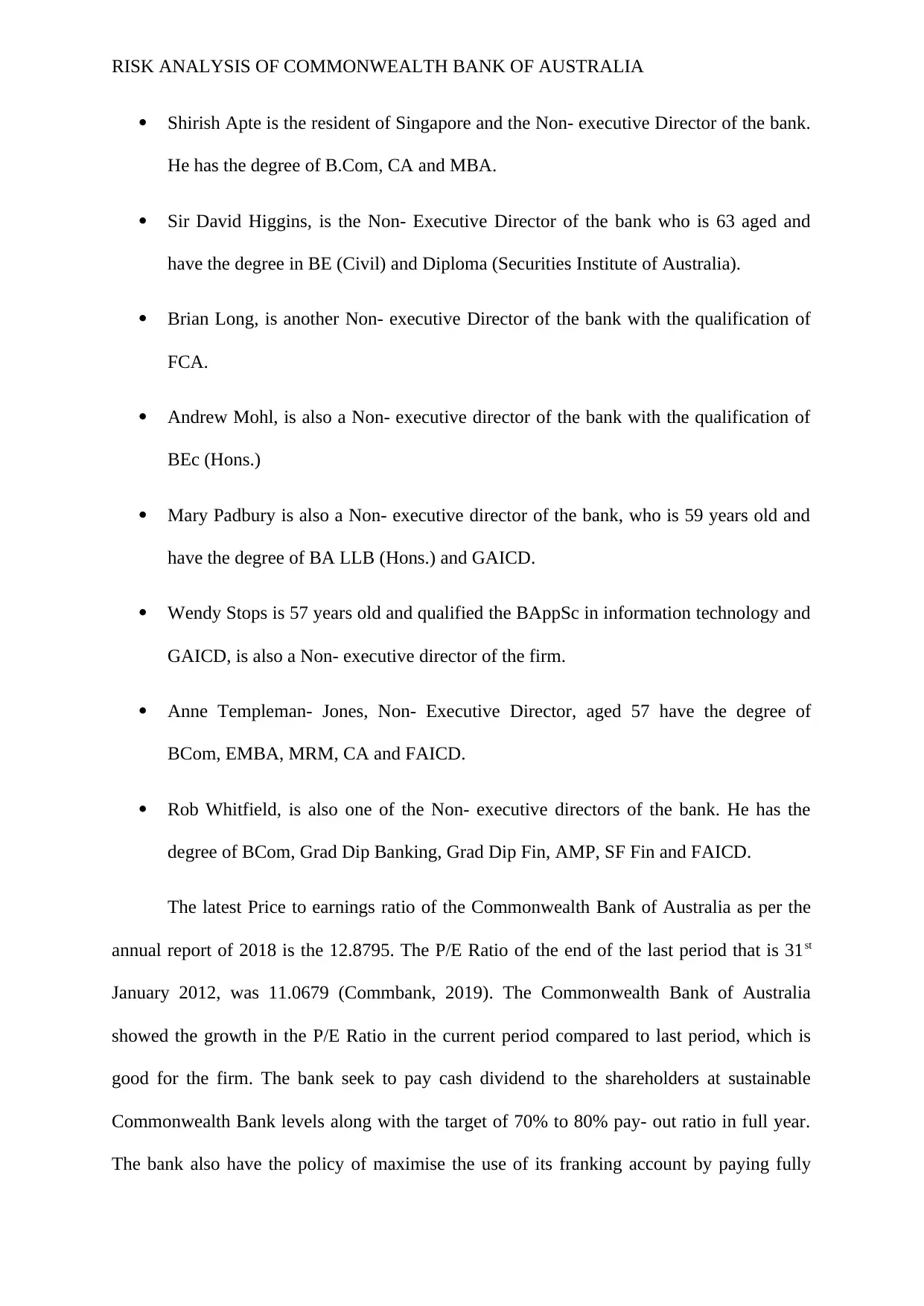
RISK ANALYSIS OF COMMONWEALTH BANK OF AUSTRALIA
Shirish Apte is the resident of Singapore and the Non- executive Director of the bank.
He has the degree of B.Com, CA and MBA.
Sir David Higgins, is the Non- Executive Director of the bank who is 63 aged and
have the degree in BE (Civil) and Diploma (Securities Institute of Australia).
Brian Long, is another Non- executive Director of the bank with the qualification of
FCA.
Andrew Mohl, is also a Non- executive director of the bank with the qualification of
BEc (Hons.)
Mary Padbury is also a Non- executive director of the bank, who is 59 years old and
have the degree of BA LLB (Hons.) and GAICD.
Wendy Stops is 57 years old and qualified the BAppSc in information technology and
GAICD, is also a Non- executive director of the firm.
Anne Templeman- Jones, Non- Executive Director, aged 57 have the degree of
BCom, EMBA, MRM, CA and FAICD.
Rob Whitfield, is also one of the Non- executive directors of the bank. He has the
degree of BCom, Grad Dip Banking, Grad Dip Fin, AMP, SF Fin and FAICD.
The latest Price to earnings ratio of the Commonwealth Bank of Australia as per the
annual report of 2018 is the 12.8795. The P/E Ratio of the end of the last period that is 31st
January 2012, was 11.0679 (Commbank, 2019). The Commonwealth Bank of Australia
showed the growth in the P/E Ratio in the current period compared to last period, which is
good for the firm. The bank seek to pay cash dividend to the shareholders at sustainable
Commonwealth Bank levels along with the target of 70% to 80% pay- out ratio in full year.
The bank also have the policy of maximise the use of its franking account by paying fully
Shirish Apte is the resident of Singapore and the Non- executive Director of the bank.
He has the degree of B.Com, CA and MBA.
Sir David Higgins, is the Non- Executive Director of the bank who is 63 aged and
have the degree in BE (Civil) and Diploma (Securities Institute of Australia).
Brian Long, is another Non- executive Director of the bank with the qualification of
FCA.
Andrew Mohl, is also a Non- executive director of the bank with the qualification of
BEc (Hons.)
Mary Padbury is also a Non- executive director of the bank, who is 59 years old and
have the degree of BA LLB (Hons.) and GAICD.
Wendy Stops is 57 years old and qualified the BAppSc in information technology and
GAICD, is also a Non- executive director of the firm.
Anne Templeman- Jones, Non- Executive Director, aged 57 have the degree of
BCom, EMBA, MRM, CA and FAICD.
Rob Whitfield, is also one of the Non- executive directors of the bank. He has the
degree of BCom, Grad Dip Banking, Grad Dip Fin, AMP, SF Fin and FAICD.
The latest Price to earnings ratio of the Commonwealth Bank of Australia as per the
annual report of 2018 is the 12.8795. The P/E Ratio of the end of the last period that is 31st
January 2012, was 11.0679 (Commbank, 2019). The Commonwealth Bank of Australia
showed the growth in the P/E Ratio in the current period compared to last period, which is
good for the firm. The bank seek to pay cash dividend to the shareholders at sustainable
Commonwealth Bank levels along with the target of 70% to 80% pay- out ratio in full year.
The bank also have the policy of maximise the use of its franking account by paying fully
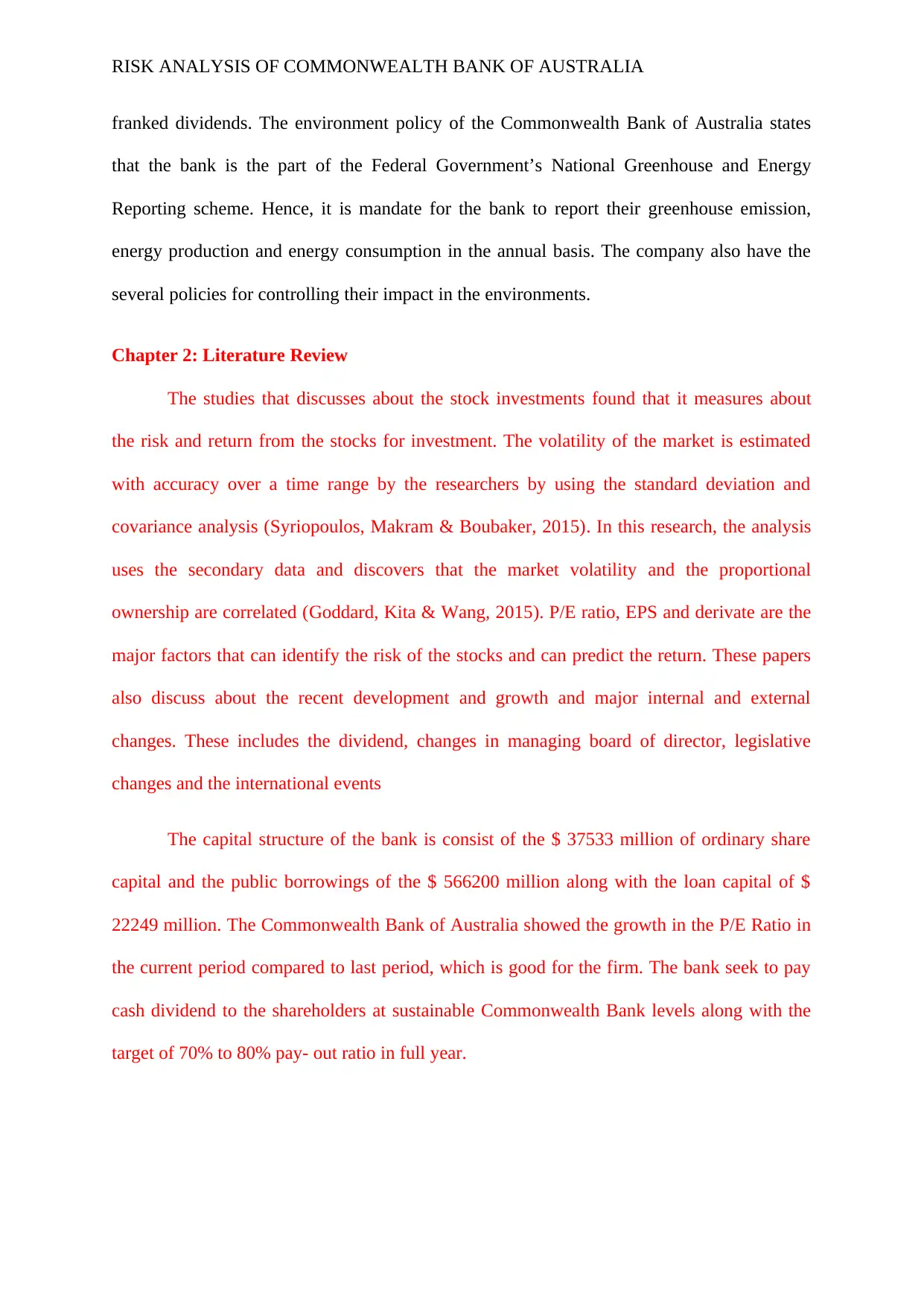
RISK ANALYSIS OF COMMONWEALTH BANK OF AUSTRALIA
franked dividends. The environment policy of the Commonwealth Bank of Australia states
that the bank is the part of the Federal Government’s National Greenhouse and Energy
Reporting scheme. Hence, it is mandate for the bank to report their greenhouse emission,
energy production and energy consumption in the annual basis. The company also have the
several policies for controlling their impact in the environments.
Chapter 2: Literature Review
The studies that discusses about the stock investments found that it measures about
the risk and return from the stocks for investment. The volatility of the market is estimated
with accuracy over a time range by the researchers by using the standard deviation and
covariance analysis (Syriopoulos, Makram & Boubaker, 2015). In this research, the analysis
uses the secondary data and discovers that the market volatility and the proportional
ownership are correlated (Goddard, Kita & Wang, 2015). P/E ratio, EPS and derivate are the
major factors that can identify the risk of the stocks and can predict the return. These papers
also discuss about the recent development and growth and major internal and external
changes. These includes the dividend, changes in managing board of director, legislative
changes and the international events
The capital structure of the bank is consist of the $ 37533 million of ordinary share
capital and the public borrowings of the $ 566200 million along with the loan capital of $
22249 million. The Commonwealth Bank of Australia showed the growth in the P/E Ratio in
the current period compared to last period, which is good for the firm. The bank seek to pay
cash dividend to the shareholders at sustainable Commonwealth Bank levels along with the
target of 70% to 80% pay- out ratio in full year.
franked dividends. The environment policy of the Commonwealth Bank of Australia states
that the bank is the part of the Federal Government’s National Greenhouse and Energy
Reporting scheme. Hence, it is mandate for the bank to report their greenhouse emission,
energy production and energy consumption in the annual basis. The company also have the
several policies for controlling their impact in the environments.
Chapter 2: Literature Review
The studies that discusses about the stock investments found that it measures about
the risk and return from the stocks for investment. The volatility of the market is estimated
with accuracy over a time range by the researchers by using the standard deviation and
covariance analysis (Syriopoulos, Makram & Boubaker, 2015). In this research, the analysis
uses the secondary data and discovers that the market volatility and the proportional
ownership are correlated (Goddard, Kita & Wang, 2015). P/E ratio, EPS and derivate are the
major factors that can identify the risk of the stocks and can predict the return. These papers
also discuss about the recent development and growth and major internal and external
changes. These includes the dividend, changes in managing board of director, legislative
changes and the international events
The capital structure of the bank is consist of the $ 37533 million of ordinary share
capital and the public borrowings of the $ 566200 million along with the loan capital of $
22249 million. The Commonwealth Bank of Australia showed the growth in the P/E Ratio in
the current period compared to last period, which is good for the firm. The bank seek to pay
cash dividend to the shareholders at sustainable Commonwealth Bank levels along with the
target of 70% to 80% pay- out ratio in full year.
Paraphrase This Document
Need a fresh take? Get an instant paraphrase of this document with our AI Paraphraser
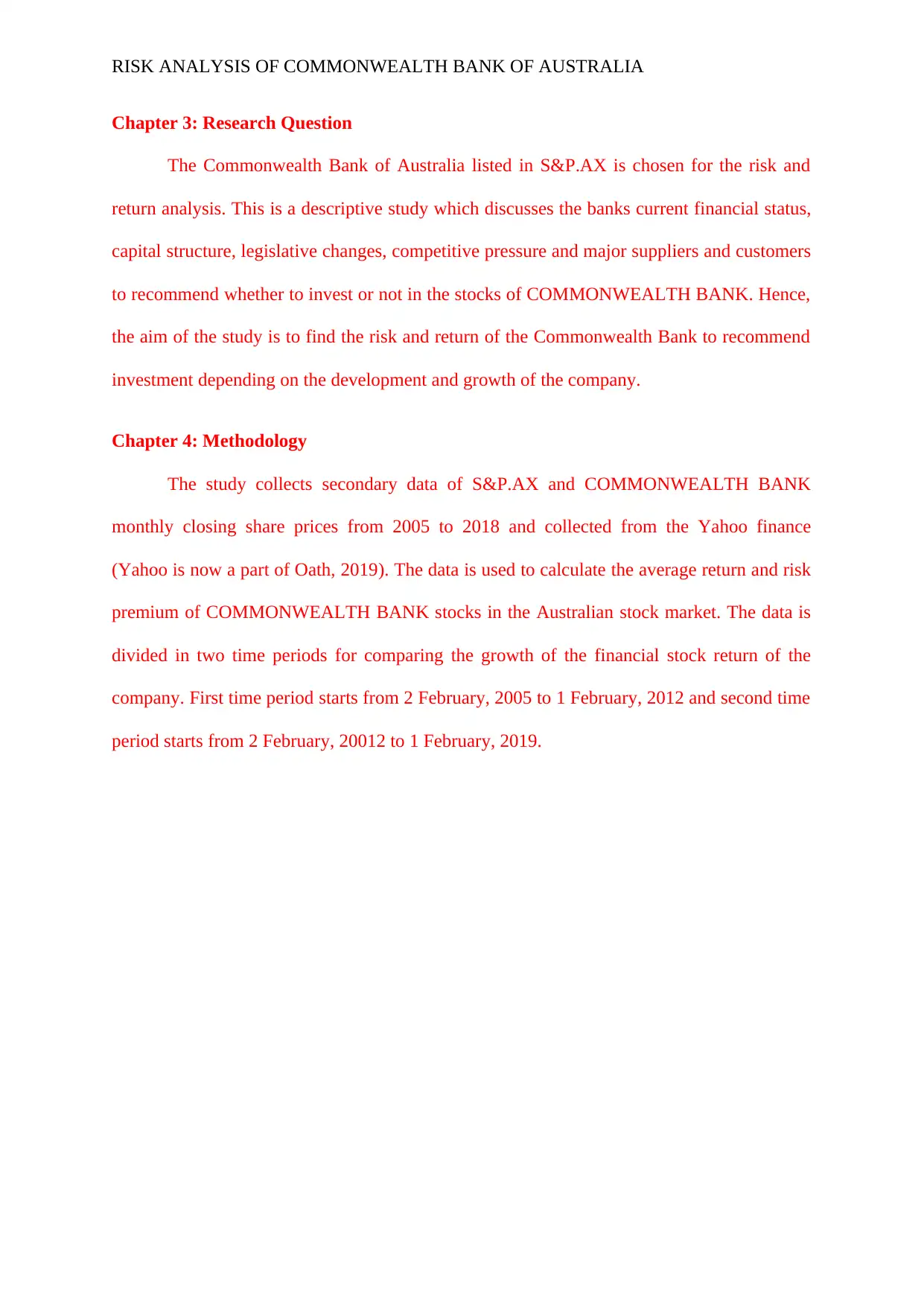
RISK ANALYSIS OF COMMONWEALTH BANK OF AUSTRALIA
Chapter 3: Research Question
The Commonwealth Bank of Australia listed in S&P.AX is chosen for the risk and
return analysis. This is a descriptive study which discusses the banks current financial status,
capital structure, legislative changes, competitive pressure and major suppliers and customers
to recommend whether to invest or not in the stocks of COMMONWEALTH BANK. Hence,
the aim of the study is to find the risk and return of the Commonwealth Bank to recommend
investment depending on the development and growth of the company.
Chapter 4: Methodology
The study collects secondary data of S&P.AX and COMMONWEALTH BANK
monthly closing share prices from 2005 to 2018 and collected from the Yahoo finance
(Yahoo is now a part of Oath, 2019). The data is used to calculate the average return and risk
premium of COMMONWEALTH BANK stocks in the Australian stock market. The data is
divided in two time periods for comparing the growth of the financial stock return of the
company. First time period starts from 2 February, 2005 to 1 February, 2012 and second time
period starts from 2 February, 20012 to 1 February, 2019.
Chapter 3: Research Question
The Commonwealth Bank of Australia listed in S&P.AX is chosen for the risk and
return analysis. This is a descriptive study which discusses the banks current financial status,
capital structure, legislative changes, competitive pressure and major suppliers and customers
to recommend whether to invest or not in the stocks of COMMONWEALTH BANK. Hence,
the aim of the study is to find the risk and return of the Commonwealth Bank to recommend
investment depending on the development and growth of the company.
Chapter 4: Methodology
The study collects secondary data of S&P.AX and COMMONWEALTH BANK
monthly closing share prices from 2005 to 2018 and collected from the Yahoo finance
(Yahoo is now a part of Oath, 2019). The data is used to calculate the average return and risk
premium of COMMONWEALTH BANK stocks in the Australian stock market. The data is
divided in two time periods for comparing the growth of the financial stock return of the
company. First time period starts from 2 February, 2005 to 1 February, 2012 and second time
period starts from 2 February, 20012 to 1 February, 2019.
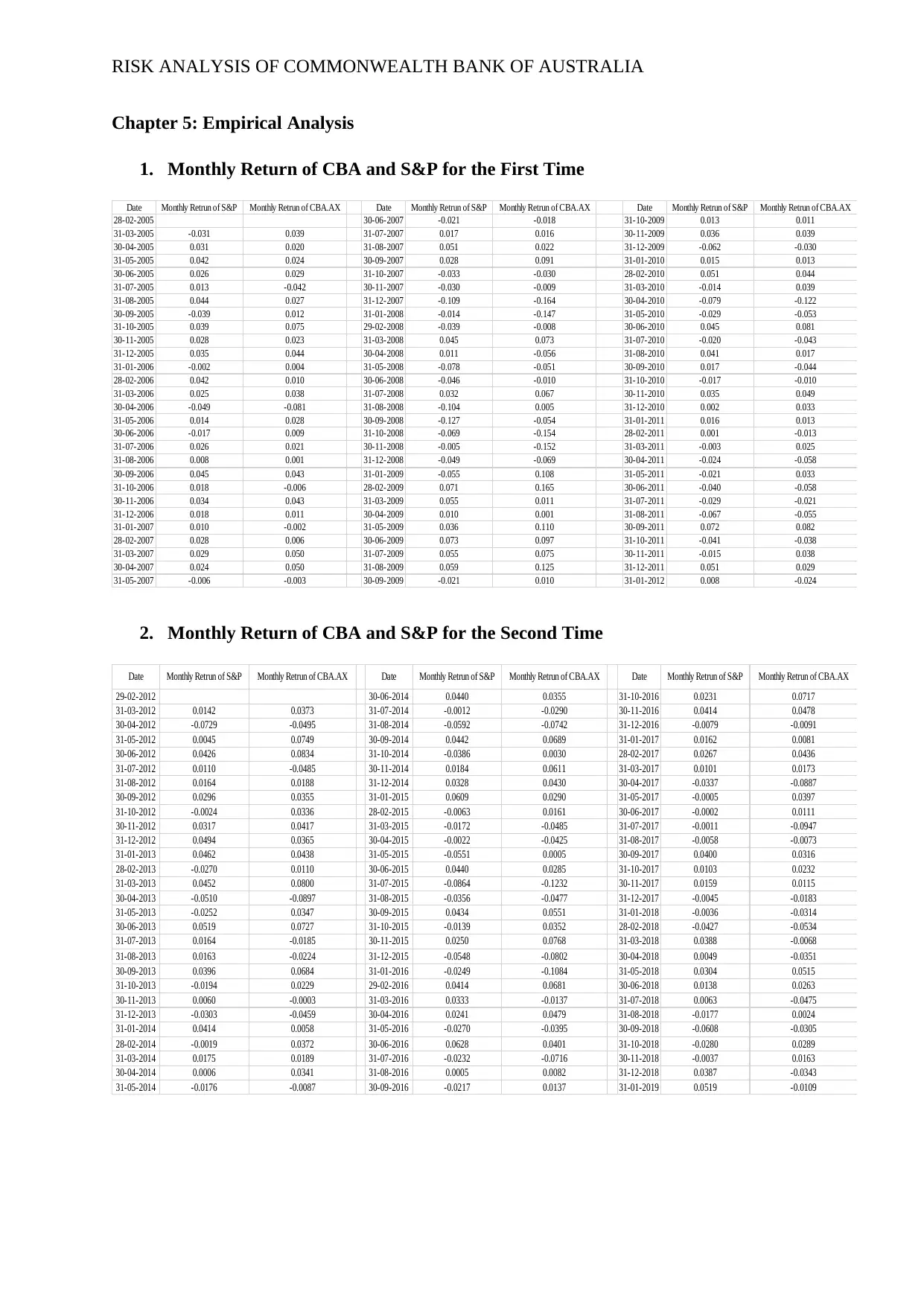
RISK ANALYSIS OF COMMONWEALTH BANK OF AUSTRALIA
Chapter 5: Empirical Analysis
1. Monthly Return of CBA and S&P for the First Time
Date Monthly Retrun of S&P Monthly Retrun of CBA.AX Date Monthly Retrun of S&P Monthly Retrun of CBA.AX Date Monthly Retrun of S&P Monthly Retrun of CBA.AX
28-02-2005 30-06-2007 -0.021 -0.018 31-10-2009 0.013 0.011
31-03-2005 -0.031 0.039 31-07-2007 0.017 0.016 30-11-2009 0.036 0.039
30-04-2005 0.031 0.020 31-08-2007 0.051 0.022 31-12-2009 -0.062 -0.030
31-05-2005 0.042 0.024 30-09-2007 0.028 0.091 31-01-2010 0.015 0.013
30-06-2005 0.026 0.029 31-10-2007 -0.033 -0.030 28-02-2010 0.051 0.044
31-07-2005 0.013 -0.042 30-11-2007 -0.030 -0.009 31-03-2010 -0.014 0.039
31-08-2005 0.044 0.027 31-12-2007 -0.109 -0.164 30-04-2010 -0.079 -0.122
30-09-2005 -0.039 0.012 31-01-2008 -0.014 -0.147 31-05-2010 -0.029 -0.053
31-10-2005 0.039 0.075 29-02-2008 -0.039 -0.008 30-06-2010 0.045 0.081
30-11-2005 0.028 0.023 31-03-2008 0.045 0.073 31-07-2010 -0.020 -0.043
31-12-2005 0.035 0.044 30-04-2008 0.011 -0.056 31-08-2010 0.041 0.017
31-01-2006 -0.002 0.004 31-05-2008 -0.078 -0.051 30-09-2010 0.017 -0.044
28-02-2006 0.042 0.010 30-06-2008 -0.046 -0.010 31-10-2010 -0.017 -0.010
31-03-2006 0.025 0.038 31-07-2008 0.032 0.067 30-11-2010 0.035 0.049
30-04-2006 -0.049 -0.081 31-08-2008 -0.104 0.005 31-12-2010 0.002 0.033
31-05-2006 0.014 0.028 30-09-2008 -0.127 -0.054 31-01-2011 0.016 0.013
30-06-2006 -0.017 0.009 31-10-2008 -0.069 -0.154 28-02-2011 0.001 -0.013
31-07-2006 0.026 0.021 30-11-2008 -0.005 -0.152 31-03-2011 -0.003 0.025
31-08-2006 0.008 0.001 31-12-2008 -0.049 -0.069 30-04-2011 -0.024 -0.058
30-09-2006 0.045 0.043 31-01-2009 -0.055 0.108 31-05-2011 -0.021 0.033
31-10-2006 0.018 -0.006 28-02-2009 0.071 0.165 30-06-2011 -0.040 -0.058
30-11-2006 0.034 0.043 31-03-2009 0.055 0.011 31-07-2011 -0.029 -0.021
31-12-2006 0.018 0.011 30-04-2009 0.010 0.001 31-08-2011 -0.067 -0.055
31-01-2007 0.010 -0.002 31-05-2009 0.036 0.110 30-09-2011 0.072 0.082
28-02-2007 0.028 0.006 30-06-2009 0.073 0.097 31-10-2011 -0.041 -0.038
31-03-2007 0.029 0.050 31-07-2009 0.055 0.075 30-11-2011 -0.015 0.038
30-04-2007 0.024 0.050 31-08-2009 0.059 0.125 31-12-2011 0.051 0.029
31-05-2007 -0.006 -0.003 30-09-2009 -0.021 0.010 31-01-2012 0.008 -0.024
2. Monthly Return of CBA and S&P for the Second Time
Date Monthly Retrun of S&P Monthly Retrun of CBA.AX Date Monthly Retrun of S&P Monthly Retrun of CBA.AX Date Monthly Retrun of S&P Monthly Retrun of CBA.AX
29-02-2012 30-06-2014 0.0440 0.0355 31-10-2016 0.0231 0.0717
31-03-2012 0.0142 0.0373 31-07-2014 -0.0012 -0.0290 30-11-2016 0.0414 0.0478
30-04-2012 -0.0729 -0.0495 31-08-2014 -0.0592 -0.0742 31-12-2016 -0.0079 -0.0091
31-05-2012 0.0045 0.0749 30-09-2014 0.0442 0.0689 31-01-2017 0.0162 0.0081
30-06-2012 0.0426 0.0834 31-10-2014 -0.0386 0.0030 28-02-2017 0.0267 0.0436
31-07-2012 0.0110 -0.0485 30-11-2014 0.0184 0.0611 31-03-2017 0.0101 0.0173
31-08-2012 0.0164 0.0188 31-12-2014 0.0328 0.0430 30-04-2017 -0.0337 -0.0887
30-09-2012 0.0296 0.0355 31-01-2015 0.0609 0.0290 31-05-2017 -0.0005 0.0397
31-10-2012 -0.0024 0.0336 28-02-2015 -0.0063 0.0161 30-06-2017 -0.0002 0.0111
30-11-2012 0.0317 0.0417 31-03-2015 -0.0172 -0.0485 31-07-2017 -0.0011 -0.0947
31-12-2012 0.0494 0.0365 30-04-2015 -0.0022 -0.0425 31-08-2017 -0.0058 -0.0073
31-01-2013 0.0462 0.0438 31-05-2015 -0.0551 0.0005 30-09-2017 0.0400 0.0316
28-02-2013 -0.0270 0.0110 30-06-2015 0.0440 0.0285 31-10-2017 0.0103 0.0232
31-03-2013 0.0452 0.0800 31-07-2015 -0.0864 -0.1232 30-11-2017 0.0159 0.0115
30-04-2013 -0.0510 -0.0897 31-08-2015 -0.0356 -0.0477 31-12-2017 -0.0045 -0.0183
31-05-2013 -0.0252 0.0347 30-09-2015 0.0434 0.0551 31-01-2018 -0.0036 -0.0314
30-06-2013 0.0519 0.0727 31-10-2015 -0.0139 0.0352 28-02-2018 -0.0427 -0.0534
31-07-2013 0.0164 -0.0185 30-11-2015 0.0250 0.0768 31-03-2018 0.0388 -0.0068
31-08-2013 0.0163 -0.0224 31-12-2015 -0.0548 -0.0802 30-04-2018 0.0049 -0.0351
30-09-2013 0.0396 0.0684 31-01-2016 -0.0249 -0.1084 31-05-2018 0.0304 0.0515
31-10-2013 -0.0194 0.0229 29-02-2016 0.0414 0.0681 30-06-2018 0.0138 0.0263
30-11-2013 0.0060 -0.0003 31-03-2016 0.0333 -0.0137 31-07-2018 0.0063 -0.0475
31-12-2013 -0.0303 -0.0459 30-04-2016 0.0241 0.0479 31-08-2018 -0.0177 0.0024
31-01-2014 0.0414 0.0058 31-05-2016 -0.0270 -0.0395 30-09-2018 -0.0608 -0.0305
28-02-2014 -0.0019 0.0372 30-06-2016 0.0628 0.0401 31-10-2018 -0.0280 0.0289
31-03-2014 0.0175 0.0189 31-07-2016 -0.0232 -0.0716 30-11-2018 -0.0037 0.0163
30-04-2014 0.0006 0.0341 31-08-2016 0.0005 0.0082 31-12-2018 0.0387 -0.0343
31-05-2014 -0.0176 -0.0087 30-09-2016 -0.0217 0.0137 31-01-2019 0.0519 -0.0109
Chapter 5: Empirical Analysis
1. Monthly Return of CBA and S&P for the First Time
Date Monthly Retrun of S&P Monthly Retrun of CBA.AX Date Monthly Retrun of S&P Monthly Retrun of CBA.AX Date Monthly Retrun of S&P Monthly Retrun of CBA.AX
28-02-2005 30-06-2007 -0.021 -0.018 31-10-2009 0.013 0.011
31-03-2005 -0.031 0.039 31-07-2007 0.017 0.016 30-11-2009 0.036 0.039
30-04-2005 0.031 0.020 31-08-2007 0.051 0.022 31-12-2009 -0.062 -0.030
31-05-2005 0.042 0.024 30-09-2007 0.028 0.091 31-01-2010 0.015 0.013
30-06-2005 0.026 0.029 31-10-2007 -0.033 -0.030 28-02-2010 0.051 0.044
31-07-2005 0.013 -0.042 30-11-2007 -0.030 -0.009 31-03-2010 -0.014 0.039
31-08-2005 0.044 0.027 31-12-2007 -0.109 -0.164 30-04-2010 -0.079 -0.122
30-09-2005 -0.039 0.012 31-01-2008 -0.014 -0.147 31-05-2010 -0.029 -0.053
31-10-2005 0.039 0.075 29-02-2008 -0.039 -0.008 30-06-2010 0.045 0.081
30-11-2005 0.028 0.023 31-03-2008 0.045 0.073 31-07-2010 -0.020 -0.043
31-12-2005 0.035 0.044 30-04-2008 0.011 -0.056 31-08-2010 0.041 0.017
31-01-2006 -0.002 0.004 31-05-2008 -0.078 -0.051 30-09-2010 0.017 -0.044
28-02-2006 0.042 0.010 30-06-2008 -0.046 -0.010 31-10-2010 -0.017 -0.010
31-03-2006 0.025 0.038 31-07-2008 0.032 0.067 30-11-2010 0.035 0.049
30-04-2006 -0.049 -0.081 31-08-2008 -0.104 0.005 31-12-2010 0.002 0.033
31-05-2006 0.014 0.028 30-09-2008 -0.127 -0.054 31-01-2011 0.016 0.013
30-06-2006 -0.017 0.009 31-10-2008 -0.069 -0.154 28-02-2011 0.001 -0.013
31-07-2006 0.026 0.021 30-11-2008 -0.005 -0.152 31-03-2011 -0.003 0.025
31-08-2006 0.008 0.001 31-12-2008 -0.049 -0.069 30-04-2011 -0.024 -0.058
30-09-2006 0.045 0.043 31-01-2009 -0.055 0.108 31-05-2011 -0.021 0.033
31-10-2006 0.018 -0.006 28-02-2009 0.071 0.165 30-06-2011 -0.040 -0.058
30-11-2006 0.034 0.043 31-03-2009 0.055 0.011 31-07-2011 -0.029 -0.021
31-12-2006 0.018 0.011 30-04-2009 0.010 0.001 31-08-2011 -0.067 -0.055
31-01-2007 0.010 -0.002 31-05-2009 0.036 0.110 30-09-2011 0.072 0.082
28-02-2007 0.028 0.006 30-06-2009 0.073 0.097 31-10-2011 -0.041 -0.038
31-03-2007 0.029 0.050 31-07-2009 0.055 0.075 30-11-2011 -0.015 0.038
30-04-2007 0.024 0.050 31-08-2009 0.059 0.125 31-12-2011 0.051 0.029
31-05-2007 -0.006 -0.003 30-09-2009 -0.021 0.010 31-01-2012 0.008 -0.024
2. Monthly Return of CBA and S&P for the Second Time
Date Monthly Retrun of S&P Monthly Retrun of CBA.AX Date Monthly Retrun of S&P Monthly Retrun of CBA.AX Date Monthly Retrun of S&P Monthly Retrun of CBA.AX
29-02-2012 30-06-2014 0.0440 0.0355 31-10-2016 0.0231 0.0717
31-03-2012 0.0142 0.0373 31-07-2014 -0.0012 -0.0290 30-11-2016 0.0414 0.0478
30-04-2012 -0.0729 -0.0495 31-08-2014 -0.0592 -0.0742 31-12-2016 -0.0079 -0.0091
31-05-2012 0.0045 0.0749 30-09-2014 0.0442 0.0689 31-01-2017 0.0162 0.0081
30-06-2012 0.0426 0.0834 31-10-2014 -0.0386 0.0030 28-02-2017 0.0267 0.0436
31-07-2012 0.0110 -0.0485 30-11-2014 0.0184 0.0611 31-03-2017 0.0101 0.0173
31-08-2012 0.0164 0.0188 31-12-2014 0.0328 0.0430 30-04-2017 -0.0337 -0.0887
30-09-2012 0.0296 0.0355 31-01-2015 0.0609 0.0290 31-05-2017 -0.0005 0.0397
31-10-2012 -0.0024 0.0336 28-02-2015 -0.0063 0.0161 30-06-2017 -0.0002 0.0111
30-11-2012 0.0317 0.0417 31-03-2015 -0.0172 -0.0485 31-07-2017 -0.0011 -0.0947
31-12-2012 0.0494 0.0365 30-04-2015 -0.0022 -0.0425 31-08-2017 -0.0058 -0.0073
31-01-2013 0.0462 0.0438 31-05-2015 -0.0551 0.0005 30-09-2017 0.0400 0.0316
28-02-2013 -0.0270 0.0110 30-06-2015 0.0440 0.0285 31-10-2017 0.0103 0.0232
31-03-2013 0.0452 0.0800 31-07-2015 -0.0864 -0.1232 30-11-2017 0.0159 0.0115
30-04-2013 -0.0510 -0.0897 31-08-2015 -0.0356 -0.0477 31-12-2017 -0.0045 -0.0183
31-05-2013 -0.0252 0.0347 30-09-2015 0.0434 0.0551 31-01-2018 -0.0036 -0.0314
30-06-2013 0.0519 0.0727 31-10-2015 -0.0139 0.0352 28-02-2018 -0.0427 -0.0534
31-07-2013 0.0164 -0.0185 30-11-2015 0.0250 0.0768 31-03-2018 0.0388 -0.0068
31-08-2013 0.0163 -0.0224 31-12-2015 -0.0548 -0.0802 30-04-2018 0.0049 -0.0351
30-09-2013 0.0396 0.0684 31-01-2016 -0.0249 -0.1084 31-05-2018 0.0304 0.0515
31-10-2013 -0.0194 0.0229 29-02-2016 0.0414 0.0681 30-06-2018 0.0138 0.0263
30-11-2013 0.0060 -0.0003 31-03-2016 0.0333 -0.0137 31-07-2018 0.0063 -0.0475
31-12-2013 -0.0303 -0.0459 30-04-2016 0.0241 0.0479 31-08-2018 -0.0177 0.0024
31-01-2014 0.0414 0.0058 31-05-2016 -0.0270 -0.0395 30-09-2018 -0.0608 -0.0305
28-02-2014 -0.0019 0.0372 30-06-2016 0.0628 0.0401 31-10-2018 -0.0280 0.0289
31-03-2014 0.0175 0.0189 31-07-2016 -0.0232 -0.0716 30-11-2018 -0.0037 0.0163
30-04-2014 0.0006 0.0341 31-08-2016 0.0005 0.0082 31-12-2018 0.0387 -0.0343
31-05-2014 -0.0176 -0.0087 30-09-2016 -0.0217 0.0137 31-01-2019 0.0519 -0.0109
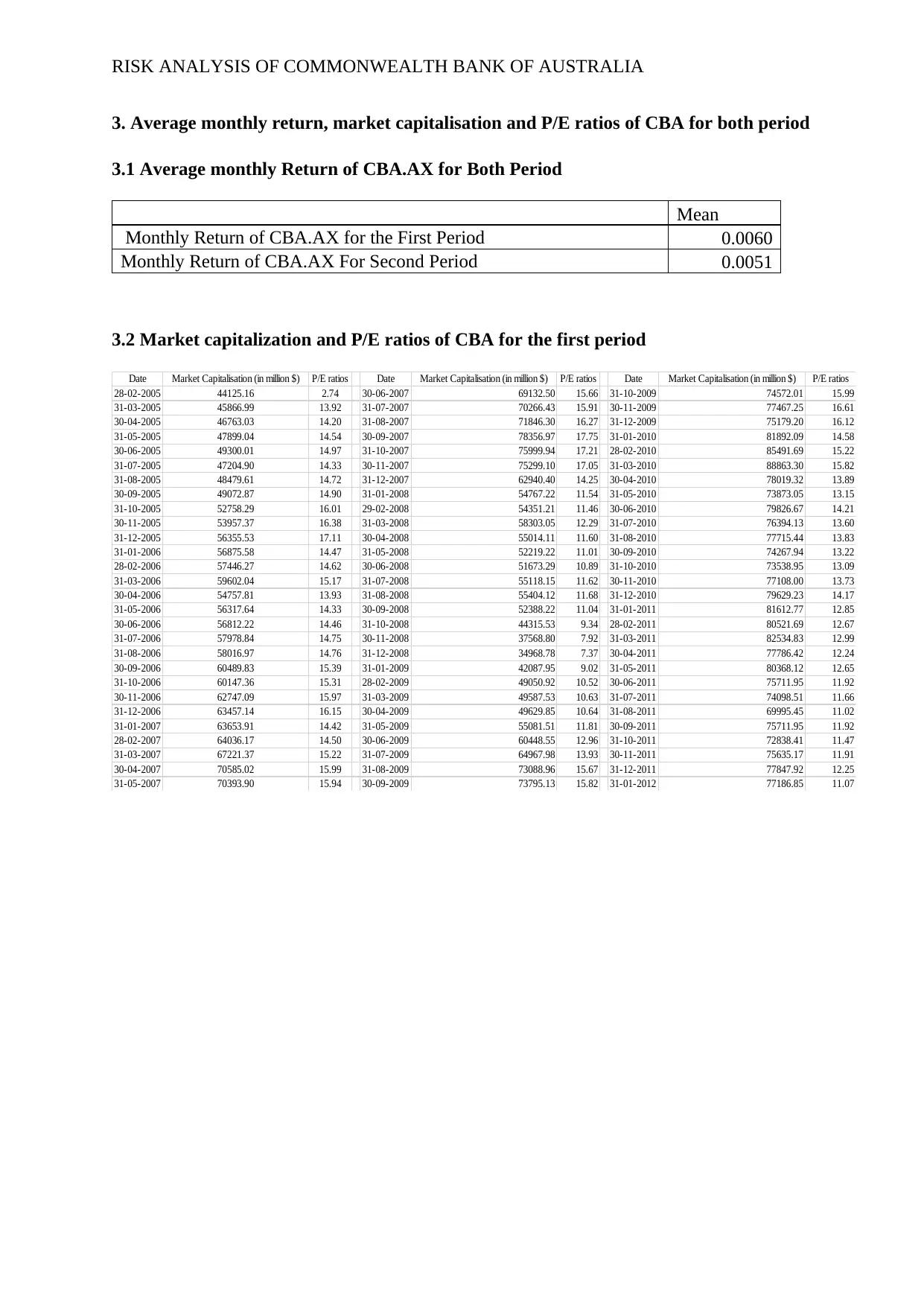
RISK ANALYSIS OF COMMONWEALTH BANK OF AUSTRALIA
3. Average monthly return, market capitalisation and P/E ratios of CBA for both period
3.1 Average monthly Return of CBA.AX for Both Period
Mean
Monthly Return of CBA.AX for the First Period 0.0060
Monthly Return of CBA.AX For Second Period 0.0051
3.2 Market capitalization and P/E ratios of CBA for the first period
Date Market Capitalisation (in million $) P/E ratios Date Market Capitalisation (in million $) P/E ratios Date Market Capitalisation (in million $) P/E ratios
28-02-2005 44125.16 2.74 30-06-2007 69132.50 15.66 31-10-2009 74572.01 15.99
31-03-2005 45866.99 13.92 31-07-2007 70266.43 15.91 30-11-2009 77467.25 16.61
30-04-2005 46763.03 14.20 31-08-2007 71846.30 16.27 31-12-2009 75179.20 16.12
31-05-2005 47899.04 14.54 30-09-2007 78356.97 17.75 31-01-2010 81892.09 14.58
30-06-2005 49300.01 14.97 31-10-2007 75999.94 17.21 28-02-2010 85491.69 15.22
31-07-2005 47204.90 14.33 30-11-2007 75299.10 17.05 31-03-2010 88863.30 15.82
31-08-2005 48479.61 14.72 31-12-2007 62940.40 14.25 30-04-2010 78019.32 13.89
30-09-2005 49072.87 14.90 31-01-2008 54767.22 11.54 31-05-2010 73873.05 13.15
31-10-2005 52758.29 16.01 29-02-2008 54351.21 11.46 30-06-2010 79826.67 14.21
30-11-2005 53957.37 16.38 31-03-2008 58303.05 12.29 31-07-2010 76394.13 13.60
31-12-2005 56355.53 17.11 30-04-2008 55014.11 11.60 31-08-2010 77715.44 13.83
31-01-2006 56875.58 14.47 31-05-2008 52219.22 11.01 30-09-2010 74267.94 13.22
28-02-2006 57446.27 14.62 30-06-2008 51673.29 10.89 31-10-2010 73538.95 13.09
31-03-2006 59602.04 15.17 31-07-2008 55118.15 11.62 30-11-2010 77108.00 13.73
30-04-2006 54757.81 13.93 31-08-2008 55404.12 11.68 31-12-2010 79629.23 14.17
31-05-2006 56317.64 14.33 30-09-2008 52388.22 11.04 31-01-2011 81612.77 12.85
30-06-2006 56812.22 14.46 31-10-2008 44315.53 9.34 28-02-2011 80521.69 12.67
31-07-2006 57978.84 14.75 30-11-2008 37568.80 7.92 31-03-2011 82534.83 12.99
31-08-2006 58016.97 14.76 31-12-2008 34968.78 7.37 30-04-2011 77786.42 12.24
30-09-2006 60489.83 15.39 31-01-2009 42087.95 9.02 31-05-2011 80368.12 12.65
31-10-2006 60147.36 15.31 28-02-2009 49050.92 10.52 30-06-2011 75711.95 11.92
30-11-2006 62747.09 15.97 31-03-2009 49587.53 10.63 31-07-2011 74098.51 11.66
31-12-2006 63457.14 16.15 30-04-2009 49629.85 10.64 31-08-2011 69995.45 11.02
31-01-2007 63653.91 14.42 31-05-2009 55081.51 11.81 30-09-2011 75711.95 11.92
28-02-2007 64036.17 14.50 30-06-2009 60448.55 12.96 31-10-2011 72838.41 11.47
31-03-2007 67221.37 15.22 31-07-2009 64967.98 13.93 30-11-2011 75635.17 11.91
30-04-2007 70585.02 15.99 31-08-2009 73088.96 15.67 31-12-2011 77847.92 12.25
31-05-2007 70393.90 15.94 30-09-2009 73795.13 15.82 31-01-2012 77186.85 11.07
3. Average monthly return, market capitalisation and P/E ratios of CBA for both period
3.1 Average monthly Return of CBA.AX for Both Period
Mean
Monthly Return of CBA.AX for the First Period 0.0060
Monthly Return of CBA.AX For Second Period 0.0051
3.2 Market capitalization and P/E ratios of CBA for the first period
Date Market Capitalisation (in million $) P/E ratios Date Market Capitalisation (in million $) P/E ratios Date Market Capitalisation (in million $) P/E ratios
28-02-2005 44125.16 2.74 30-06-2007 69132.50 15.66 31-10-2009 74572.01 15.99
31-03-2005 45866.99 13.92 31-07-2007 70266.43 15.91 30-11-2009 77467.25 16.61
30-04-2005 46763.03 14.20 31-08-2007 71846.30 16.27 31-12-2009 75179.20 16.12
31-05-2005 47899.04 14.54 30-09-2007 78356.97 17.75 31-01-2010 81892.09 14.58
30-06-2005 49300.01 14.97 31-10-2007 75999.94 17.21 28-02-2010 85491.69 15.22
31-07-2005 47204.90 14.33 30-11-2007 75299.10 17.05 31-03-2010 88863.30 15.82
31-08-2005 48479.61 14.72 31-12-2007 62940.40 14.25 30-04-2010 78019.32 13.89
30-09-2005 49072.87 14.90 31-01-2008 54767.22 11.54 31-05-2010 73873.05 13.15
31-10-2005 52758.29 16.01 29-02-2008 54351.21 11.46 30-06-2010 79826.67 14.21
30-11-2005 53957.37 16.38 31-03-2008 58303.05 12.29 31-07-2010 76394.13 13.60
31-12-2005 56355.53 17.11 30-04-2008 55014.11 11.60 31-08-2010 77715.44 13.83
31-01-2006 56875.58 14.47 31-05-2008 52219.22 11.01 30-09-2010 74267.94 13.22
28-02-2006 57446.27 14.62 30-06-2008 51673.29 10.89 31-10-2010 73538.95 13.09
31-03-2006 59602.04 15.17 31-07-2008 55118.15 11.62 30-11-2010 77108.00 13.73
30-04-2006 54757.81 13.93 31-08-2008 55404.12 11.68 31-12-2010 79629.23 14.17
31-05-2006 56317.64 14.33 30-09-2008 52388.22 11.04 31-01-2011 81612.77 12.85
30-06-2006 56812.22 14.46 31-10-2008 44315.53 9.34 28-02-2011 80521.69 12.67
31-07-2006 57978.84 14.75 30-11-2008 37568.80 7.92 31-03-2011 82534.83 12.99
31-08-2006 58016.97 14.76 31-12-2008 34968.78 7.37 30-04-2011 77786.42 12.24
30-09-2006 60489.83 15.39 31-01-2009 42087.95 9.02 31-05-2011 80368.12 12.65
31-10-2006 60147.36 15.31 28-02-2009 49050.92 10.52 30-06-2011 75711.95 11.92
30-11-2006 62747.09 15.97 31-03-2009 49587.53 10.63 31-07-2011 74098.51 11.66
31-12-2006 63457.14 16.15 30-04-2009 49629.85 10.64 31-08-2011 69995.45 11.02
31-01-2007 63653.91 14.42 31-05-2009 55081.51 11.81 30-09-2011 75711.95 11.92
28-02-2007 64036.17 14.50 30-06-2009 60448.55 12.96 31-10-2011 72838.41 11.47
31-03-2007 67221.37 15.22 31-07-2009 64967.98 13.93 30-11-2011 75635.17 11.91
30-04-2007 70585.02 15.99 31-08-2009 73088.96 15.67 31-12-2011 77847.92 12.25
31-05-2007 70393.90 15.94 30-09-2009 73795.13 15.82 31-01-2012 77186.85 11.07
Secure Best Marks with AI Grader
Need help grading? Try our AI Grader for instant feedback on your assignments.
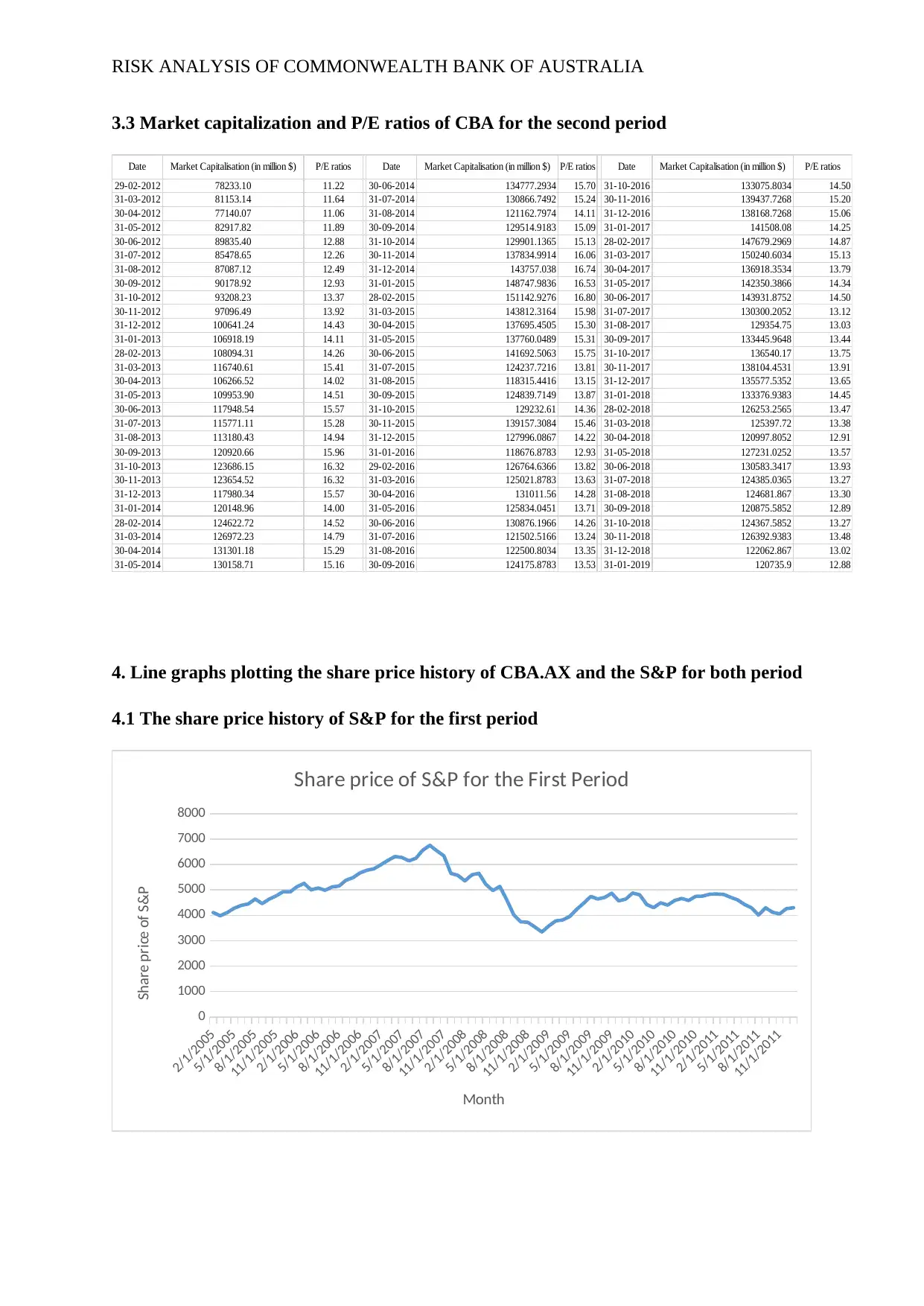
RISK ANALYSIS OF COMMONWEALTH BANK OF AUSTRALIA
3.3 Market capitalization and P/E ratios of CBA for the second period
Date Market Capitalisation (in million $) P/E ratios Date Market Capitalisation (in million $) P/E ratios Date Market Capitalisation (in million $) P/E ratios
29-02-2012 78233.10 11.22 30-06-2014 134777.2934 15.70 31-10-2016 133075.8034 14.50
31-03-2012 81153.14 11.64 31-07-2014 130866.7492 15.24 30-11-2016 139437.7268 15.20
30-04-2012 77140.07 11.06 31-08-2014 121162.7974 14.11 31-12-2016 138168.7268 15.06
31-05-2012 82917.82 11.89 30-09-2014 129514.9183 15.09 31-01-2017 141508.08 14.25
30-06-2012 89835.40 12.88 31-10-2014 129901.1365 15.13 28-02-2017 147679.2969 14.87
31-07-2012 85478.65 12.26 30-11-2014 137834.9914 16.06 31-03-2017 150240.6034 15.13
31-08-2012 87087.12 12.49 31-12-2014 143757.038 16.74 30-04-2017 136918.3534 13.79
30-09-2012 90178.92 12.93 31-01-2015 148747.9836 16.53 31-05-2017 142350.3866 14.34
31-10-2012 93208.23 13.37 28-02-2015 151142.9276 16.80 30-06-2017 143931.8752 14.50
30-11-2012 97096.49 13.92 31-03-2015 143812.3164 15.98 31-07-2017 130300.2052 13.12
31-12-2012 100641.24 14.43 30-04-2015 137695.4505 15.30 31-08-2017 129354.75 13.03
31-01-2013 106918.19 14.11 31-05-2015 137760.0489 15.31 30-09-2017 133445.9648 13.44
28-02-2013 108094.31 14.26 30-06-2015 141692.5063 15.75 31-10-2017 136540.17 13.75
31-03-2013 116740.61 15.41 31-07-2015 124237.7216 13.81 30-11-2017 138104.4531 13.91
30-04-2013 106266.52 14.02 31-08-2015 118315.4416 13.15 31-12-2017 135577.5352 13.65
31-05-2013 109953.90 14.51 30-09-2015 124839.7149 13.87 31-01-2018 133376.9383 14.45
30-06-2013 117948.54 15.57 31-10-2015 129232.61 14.36 28-02-2018 126253.2565 13.47
31-07-2013 115771.11 15.28 30-11-2015 139157.3084 15.46 31-03-2018 125397.72 13.38
31-08-2013 113180.43 14.94 31-12-2015 127996.0867 14.22 30-04-2018 120997.8052 12.91
30-09-2013 120920.66 15.96 31-01-2016 118676.8783 12.93 31-05-2018 127231.0252 13.57
31-10-2013 123686.15 16.32 29-02-2016 126764.6366 13.82 30-06-2018 130583.3417 13.93
30-11-2013 123654.52 16.32 31-03-2016 125021.8783 13.63 31-07-2018 124385.0365 13.27
31-12-2013 117980.34 15.57 30-04-2016 131011.56 14.28 31-08-2018 124681.867 13.30
31-01-2014 120148.96 14.00 31-05-2016 125834.0451 13.71 30-09-2018 120875.5852 12.89
28-02-2014 124622.72 14.52 30-06-2016 130876.1966 14.26 31-10-2018 124367.5852 13.27
31-03-2014 126972.23 14.79 31-07-2016 121502.5166 13.24 30-11-2018 126392.9383 13.48
30-04-2014 131301.18 15.29 31-08-2016 122500.8034 13.35 31-12-2018 122062.867 13.02
31-05-2014 130158.71 15.16 30-09-2016 124175.8783 13.53 31-01-2019 120735.9 12.88
4. Line graphs plotting the share price history of CBA.AX and the S&P for both period
4.1 The share price history of S&P for the first period
2/1/2005
5/1/2005
8/1/2005
11/1/2005
2/1/2006
5/1/2006
8/1/2006
11/1/2006
2/1/2007
5/1/2007
8/1/2007
11/1/2007
2/1/2008
5/1/2008
8/1/2008
11/1/2008
2/1/2009
5/1/2009
8/1/2009
11/1/2009
2/1/2010
5/1/2010
8/1/2010
11/1/2010
2/1/2011
5/1/2011
8/1/2011
11/1/2011
0
1000
2000
3000
4000
5000
6000
7000
8000
Share price of S&P for the First Period
Month
Share price of S&P
3.3 Market capitalization and P/E ratios of CBA for the second period
Date Market Capitalisation (in million $) P/E ratios Date Market Capitalisation (in million $) P/E ratios Date Market Capitalisation (in million $) P/E ratios
29-02-2012 78233.10 11.22 30-06-2014 134777.2934 15.70 31-10-2016 133075.8034 14.50
31-03-2012 81153.14 11.64 31-07-2014 130866.7492 15.24 30-11-2016 139437.7268 15.20
30-04-2012 77140.07 11.06 31-08-2014 121162.7974 14.11 31-12-2016 138168.7268 15.06
31-05-2012 82917.82 11.89 30-09-2014 129514.9183 15.09 31-01-2017 141508.08 14.25
30-06-2012 89835.40 12.88 31-10-2014 129901.1365 15.13 28-02-2017 147679.2969 14.87
31-07-2012 85478.65 12.26 30-11-2014 137834.9914 16.06 31-03-2017 150240.6034 15.13
31-08-2012 87087.12 12.49 31-12-2014 143757.038 16.74 30-04-2017 136918.3534 13.79
30-09-2012 90178.92 12.93 31-01-2015 148747.9836 16.53 31-05-2017 142350.3866 14.34
31-10-2012 93208.23 13.37 28-02-2015 151142.9276 16.80 30-06-2017 143931.8752 14.50
30-11-2012 97096.49 13.92 31-03-2015 143812.3164 15.98 31-07-2017 130300.2052 13.12
31-12-2012 100641.24 14.43 30-04-2015 137695.4505 15.30 31-08-2017 129354.75 13.03
31-01-2013 106918.19 14.11 31-05-2015 137760.0489 15.31 30-09-2017 133445.9648 13.44
28-02-2013 108094.31 14.26 30-06-2015 141692.5063 15.75 31-10-2017 136540.17 13.75
31-03-2013 116740.61 15.41 31-07-2015 124237.7216 13.81 30-11-2017 138104.4531 13.91
30-04-2013 106266.52 14.02 31-08-2015 118315.4416 13.15 31-12-2017 135577.5352 13.65
31-05-2013 109953.90 14.51 30-09-2015 124839.7149 13.87 31-01-2018 133376.9383 14.45
30-06-2013 117948.54 15.57 31-10-2015 129232.61 14.36 28-02-2018 126253.2565 13.47
31-07-2013 115771.11 15.28 30-11-2015 139157.3084 15.46 31-03-2018 125397.72 13.38
31-08-2013 113180.43 14.94 31-12-2015 127996.0867 14.22 30-04-2018 120997.8052 12.91
30-09-2013 120920.66 15.96 31-01-2016 118676.8783 12.93 31-05-2018 127231.0252 13.57
31-10-2013 123686.15 16.32 29-02-2016 126764.6366 13.82 30-06-2018 130583.3417 13.93
30-11-2013 123654.52 16.32 31-03-2016 125021.8783 13.63 31-07-2018 124385.0365 13.27
31-12-2013 117980.34 15.57 30-04-2016 131011.56 14.28 31-08-2018 124681.867 13.30
31-01-2014 120148.96 14.00 31-05-2016 125834.0451 13.71 30-09-2018 120875.5852 12.89
28-02-2014 124622.72 14.52 30-06-2016 130876.1966 14.26 31-10-2018 124367.5852 13.27
31-03-2014 126972.23 14.79 31-07-2016 121502.5166 13.24 30-11-2018 126392.9383 13.48
30-04-2014 131301.18 15.29 31-08-2016 122500.8034 13.35 31-12-2018 122062.867 13.02
31-05-2014 130158.71 15.16 30-09-2016 124175.8783 13.53 31-01-2019 120735.9 12.88
4. Line graphs plotting the share price history of CBA.AX and the S&P for both period
4.1 The share price history of S&P for the first period
2/1/2005
5/1/2005
8/1/2005
11/1/2005
2/1/2006
5/1/2006
8/1/2006
11/1/2006
2/1/2007
5/1/2007
8/1/2007
11/1/2007
2/1/2008
5/1/2008
8/1/2008
11/1/2008
2/1/2009
5/1/2009
8/1/2009
11/1/2009
2/1/2010
5/1/2010
8/1/2010
11/1/2010
2/1/2011
5/1/2011
8/1/2011
11/1/2011
0
1000
2000
3000
4000
5000
6000
7000
8000
Share price of S&P for the First Period
Month
Share price of S&P
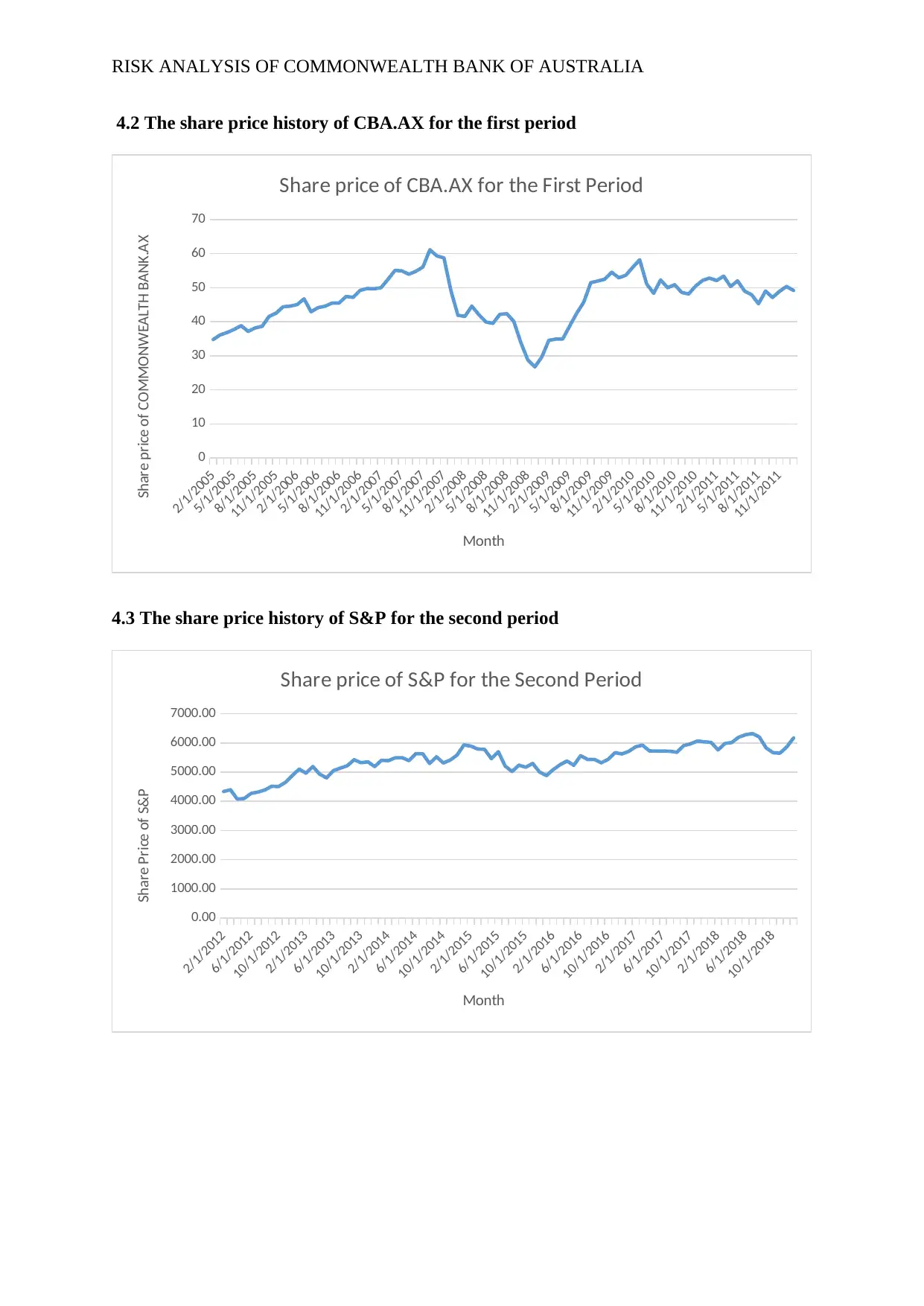
RISK ANALYSIS OF COMMONWEALTH BANK OF AUSTRALIA
4.2 The share price history of CBA.AX for the first period
2/1/2005
5/1/2005
8/1/2005
11/1/2005
2/1/2006
5/1/2006
8/1/2006
11/1/2006
2/1/2007
5/1/2007
8/1/2007
11/1/2007
2/1/2008
5/1/2008
8/1/2008
11/1/2008
2/1/2009
5/1/2009
8/1/2009
11/1/2009
2/1/2010
5/1/2010
8/1/2010
11/1/2010
2/1/2011
5/1/2011
8/1/2011
11/1/2011
0
10
20
30
40
50
60
70
Share price of CBA.AX for the First Period
Month
Share price of COMMONWEALTH BANK.AX
4.3 The share price history of S&P for the second period
2/1/2012
6/1/2012
10/1/2012
2/1/2013
6/1/2013
10/1/2013
2/1/2014
6/1/2014
10/1/2014
2/1/2015
6/1/2015
10/1/2015
2/1/2016
6/1/2016
10/1/2016
2/1/2017
6/1/2017
10/1/2017
2/1/2018
6/1/2018
10/1/2018
0.00
1000.00
2000.00
3000.00
4000.00
5000.00
6000.00
7000.00
Share price of S&P for the Second Period
Month
Share Price of S&P
4.2 The share price history of CBA.AX for the first period
2/1/2005
5/1/2005
8/1/2005
11/1/2005
2/1/2006
5/1/2006
8/1/2006
11/1/2006
2/1/2007
5/1/2007
8/1/2007
11/1/2007
2/1/2008
5/1/2008
8/1/2008
11/1/2008
2/1/2009
5/1/2009
8/1/2009
11/1/2009
2/1/2010
5/1/2010
8/1/2010
11/1/2010
2/1/2011
5/1/2011
8/1/2011
11/1/2011
0
10
20
30
40
50
60
70
Share price of CBA.AX for the First Period
Month
Share price of COMMONWEALTH BANK.AX
4.3 The share price history of S&P for the second period
2/1/2012
6/1/2012
10/1/2012
2/1/2013
6/1/2013
10/1/2013
2/1/2014
6/1/2014
10/1/2014
2/1/2015
6/1/2015
10/1/2015
2/1/2016
6/1/2016
10/1/2016
2/1/2017
6/1/2017
10/1/2017
2/1/2018
6/1/2018
10/1/2018
0.00
1000.00
2000.00
3000.00
4000.00
5000.00
6000.00
7000.00
Share price of S&P for the Second Period
Month
Share Price of S&P
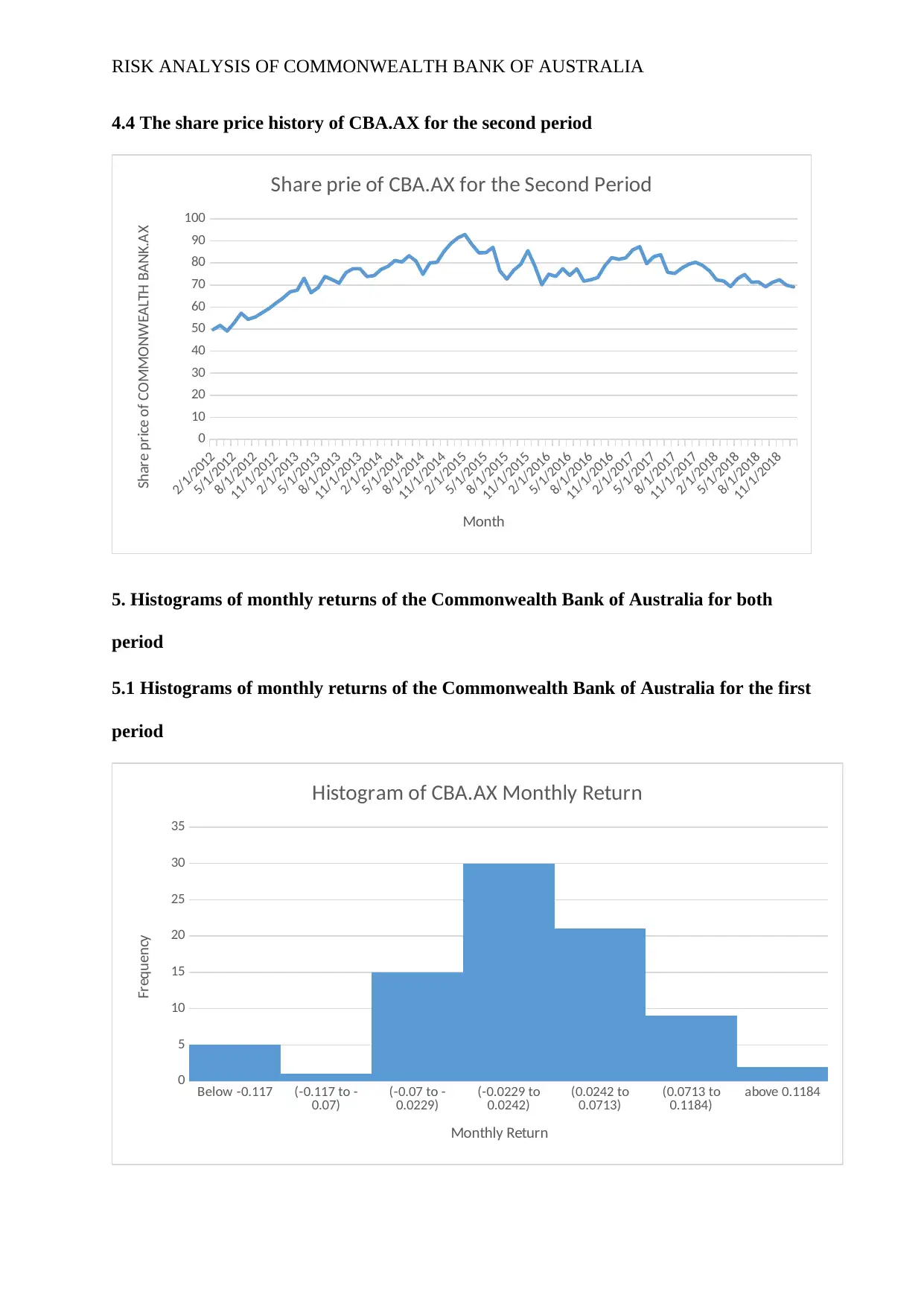
RISK ANALYSIS OF COMMONWEALTH BANK OF AUSTRALIA
4.4 The share price history of CBA.AX for the second period
2/1/2012
5/1/2012
8/1/2012
11/1/2012
2/1/2013
5/1/2013
8/1/2013
11/1/2013
2/1/2014
5/1/2014
8/1/2014
11/1/2014
2/1/2015
5/1/2015
8/1/2015
11/1/2015
2/1/2016
5/1/2016
8/1/2016
11/1/2016
2/1/2017
5/1/2017
8/1/2017
11/1/2017
2/1/2018
5/1/2018
8/1/2018
11/1/2018
0
10
20
30
40
50
60
70
80
90
100
Share prie of CBA.AX for the Second Period
Month
Share price of COMMONWEALTH BANK.AX
5. Histograms of monthly returns of the Commonwealth Bank of Australia for both
period
5.1 Histograms of monthly returns of the Commonwealth Bank of Australia for the first
period
Below -0.117 (-0.117 to -
0.07) (-0.07 to -
0.0229) (-0.0229 to
0.0242) (0.0242 to
0.0713) (0.0713 to
0.1184) above 0.1184
0
5
10
15
20
25
30
35
Histogram of CBA.AX Monthly Return
Monthly Return
Frequency
4.4 The share price history of CBA.AX for the second period
2/1/2012
5/1/2012
8/1/2012
11/1/2012
2/1/2013
5/1/2013
8/1/2013
11/1/2013
2/1/2014
5/1/2014
8/1/2014
11/1/2014
2/1/2015
5/1/2015
8/1/2015
11/1/2015
2/1/2016
5/1/2016
8/1/2016
11/1/2016
2/1/2017
5/1/2017
8/1/2017
11/1/2017
2/1/2018
5/1/2018
8/1/2018
11/1/2018
0
10
20
30
40
50
60
70
80
90
100
Share prie of CBA.AX for the Second Period
Month
Share price of COMMONWEALTH BANK.AX
5. Histograms of monthly returns of the Commonwealth Bank of Australia for both
period
5.1 Histograms of monthly returns of the Commonwealth Bank of Australia for the first
period
Below -0.117 (-0.117 to -
0.07) (-0.07 to -
0.0229) (-0.0229 to
0.0242) (0.0242 to
0.0713) (0.0713 to
0.1184) above 0.1184
0
5
10
15
20
25
30
35
Histogram of CBA.AX Monthly Return
Monthly Return
Frequency
Paraphrase This Document
Need a fresh take? Get an instant paraphrase of this document with our AI Paraphraser
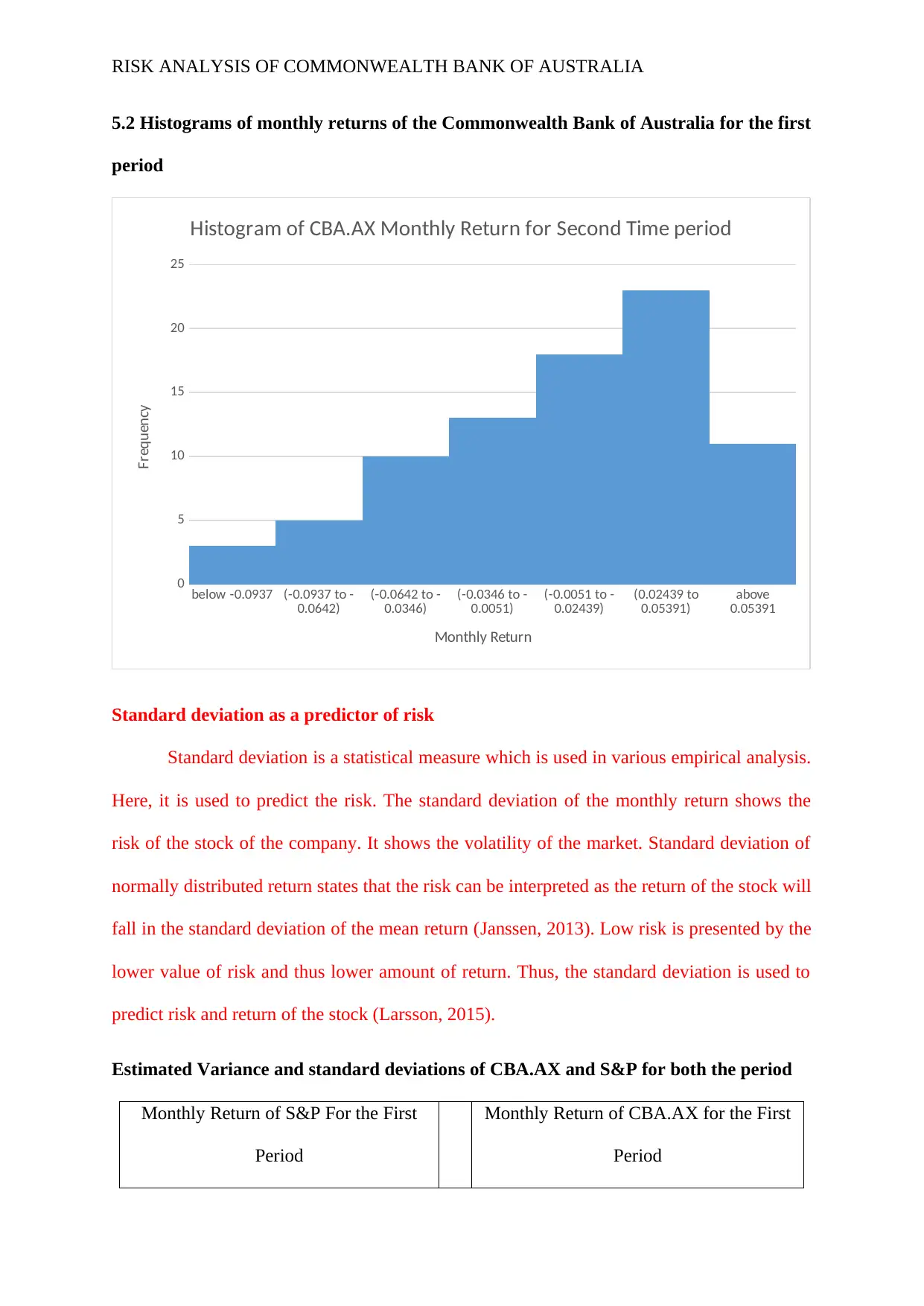
RISK ANALYSIS OF COMMONWEALTH BANK OF AUSTRALIA
5.2 Histograms of monthly returns of the Commonwealth Bank of Australia for the first
period
below -0.0937 (-0.0937 to -
0.0642) (-0.0642 to -
0.0346) (-0.0346 to -
0.0051) (-0.0051 to -
0.02439) (0.02439 to
0.05391) above
0.05391
0
5
10
15
20
25
Histogram of CBA.AX Monthly Return for Second Time period
Monthly Return
Frequency
Standard deviation as a predictor of risk
Standard deviation is a statistical measure which is used in various empirical analysis.
Here, it is used to predict the risk. The standard deviation of the monthly return shows the
risk of the stock of the company. It shows the volatility of the market. Standard deviation of
normally distributed return states that the risk can be interpreted as the return of the stock will
fall in the standard deviation of the mean return (Janssen, 2013). Low risk is presented by the
lower value of risk and thus lower amount of return. Thus, the standard deviation is used to
predict risk and return of the stock (Larsson, 2015).
Estimated Variance and standard deviations of CBA.AX and S&P for both the period
Monthly Return of S&P For the First
Period
Monthly Return of CBA.AX for the First
Period
5.2 Histograms of monthly returns of the Commonwealth Bank of Australia for the first
period
below -0.0937 (-0.0937 to -
0.0642) (-0.0642 to -
0.0346) (-0.0346 to -
0.0051) (-0.0051 to -
0.02439) (0.02439 to
0.05391) above
0.05391
0
5
10
15
20
25
Histogram of CBA.AX Monthly Return for Second Time period
Monthly Return
Frequency
Standard deviation as a predictor of risk
Standard deviation is a statistical measure which is used in various empirical analysis.
Here, it is used to predict the risk. The standard deviation of the monthly return shows the
risk of the stock of the company. It shows the volatility of the market. Standard deviation of
normally distributed return states that the risk can be interpreted as the return of the stock will
fall in the standard deviation of the mean return (Janssen, 2013). Low risk is presented by the
lower value of risk and thus lower amount of return. Thus, the standard deviation is used to
predict risk and return of the stock (Larsson, 2015).
Estimated Variance and standard deviations of CBA.AX and S&P for both the period
Monthly Return of S&P For the First
Period
Monthly Return of CBA.AX for the First
Period
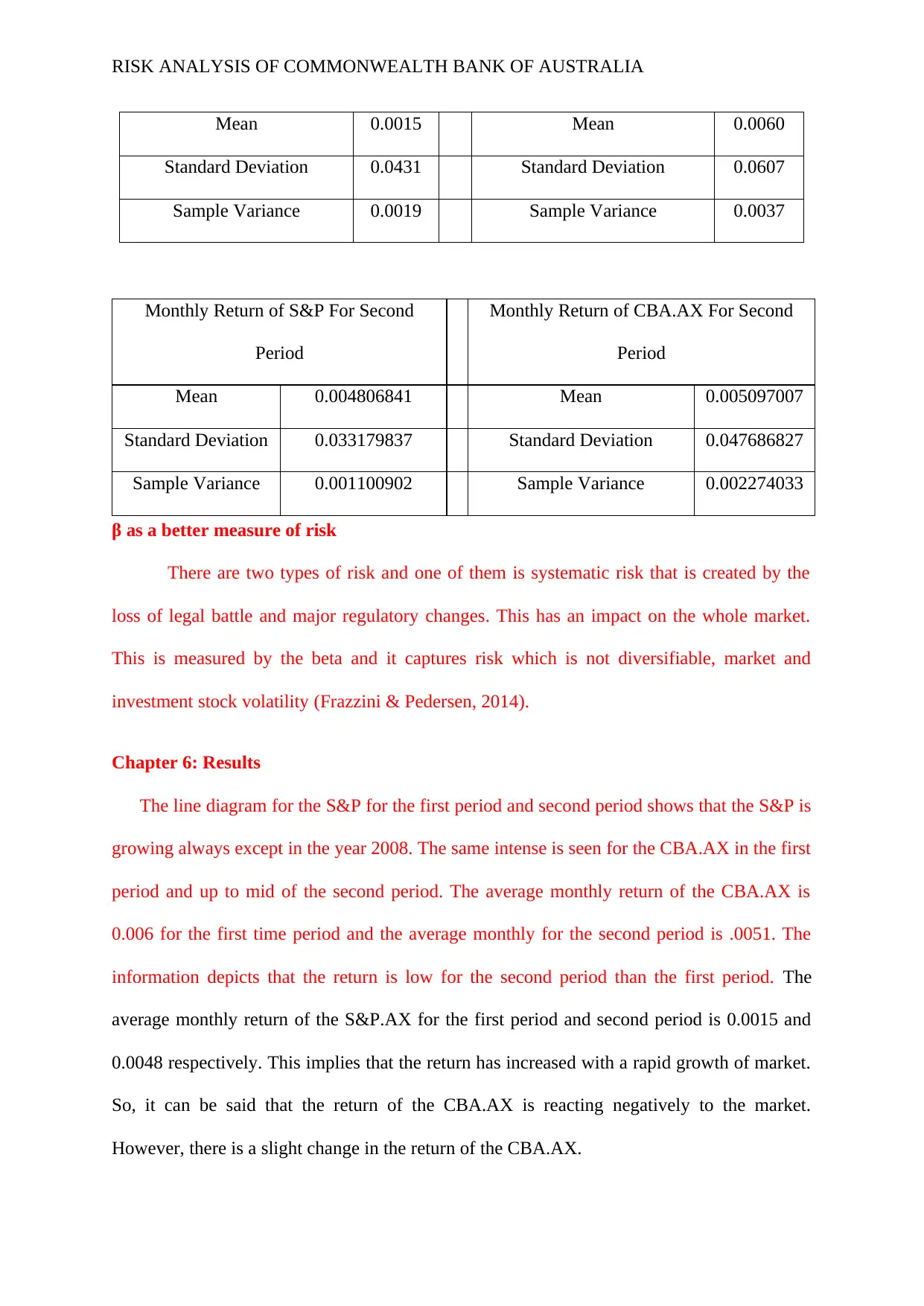
RISK ANALYSIS OF COMMONWEALTH BANK OF AUSTRALIA
Mean 0.0015 Mean 0.0060
Standard Deviation 0.0431 Standard Deviation 0.0607
Sample Variance 0.0019 Sample Variance 0.0037
Monthly Return of S&P For Second
Period
Monthly Return of CBA.AX For Second
Period
Mean 0.004806841 Mean 0.005097007
Standard Deviation 0.033179837 Standard Deviation 0.047686827
Sample Variance 0.001100902 Sample Variance 0.002274033
β as a better measure of risk
There are two types of risk and one of them is systematic risk that is created by the
loss of legal battle and major regulatory changes. This has an impact on the whole market.
This is measured by the beta and it captures risk which is not diversifiable, market and
investment stock volatility (Frazzini & Pedersen, 2014).
Chapter 6: Results
The line diagram for the S&P for the first period and second period shows that the S&P is
growing always except in the year 2008. The same intense is seen for the CBA.AX in the first
period and up to mid of the second period. The average monthly return of the CBA.AX is
0.006 for the first time period and the average monthly for the second period is .0051. The
information depicts that the return is low for the second period than the first period. The
average monthly return of the S&P.AX for the first period and second period is 0.0015 and
0.0048 respectively. This implies that the return has increased with a rapid growth of market.
So, it can be said that the return of the CBA.AX is reacting negatively to the market.
However, there is a slight change in the return of the CBA.AX.
Mean 0.0015 Mean 0.0060
Standard Deviation 0.0431 Standard Deviation 0.0607
Sample Variance 0.0019 Sample Variance 0.0037
Monthly Return of S&P For Second
Period
Monthly Return of CBA.AX For Second
Period
Mean 0.004806841 Mean 0.005097007
Standard Deviation 0.033179837 Standard Deviation 0.047686827
Sample Variance 0.001100902 Sample Variance 0.002274033
β as a better measure of risk
There are two types of risk and one of them is systematic risk that is created by the
loss of legal battle and major regulatory changes. This has an impact on the whole market.
This is measured by the beta and it captures risk which is not diversifiable, market and
investment stock volatility (Frazzini & Pedersen, 2014).
Chapter 6: Results
The line diagram for the S&P for the first period and second period shows that the S&P is
growing always except in the year 2008. The same intense is seen for the CBA.AX in the first
period and up to mid of the second period. The average monthly return of the CBA.AX is
0.006 for the first time period and the average monthly for the second period is .0051. The
information depicts that the return is low for the second period than the first period. The
average monthly return of the S&P.AX for the first period and second period is 0.0015 and
0.0048 respectively. This implies that the return has increased with a rapid growth of market.
So, it can be said that the return of the CBA.AX is reacting negatively to the market.
However, there is a slight change in the return of the CBA.AX.
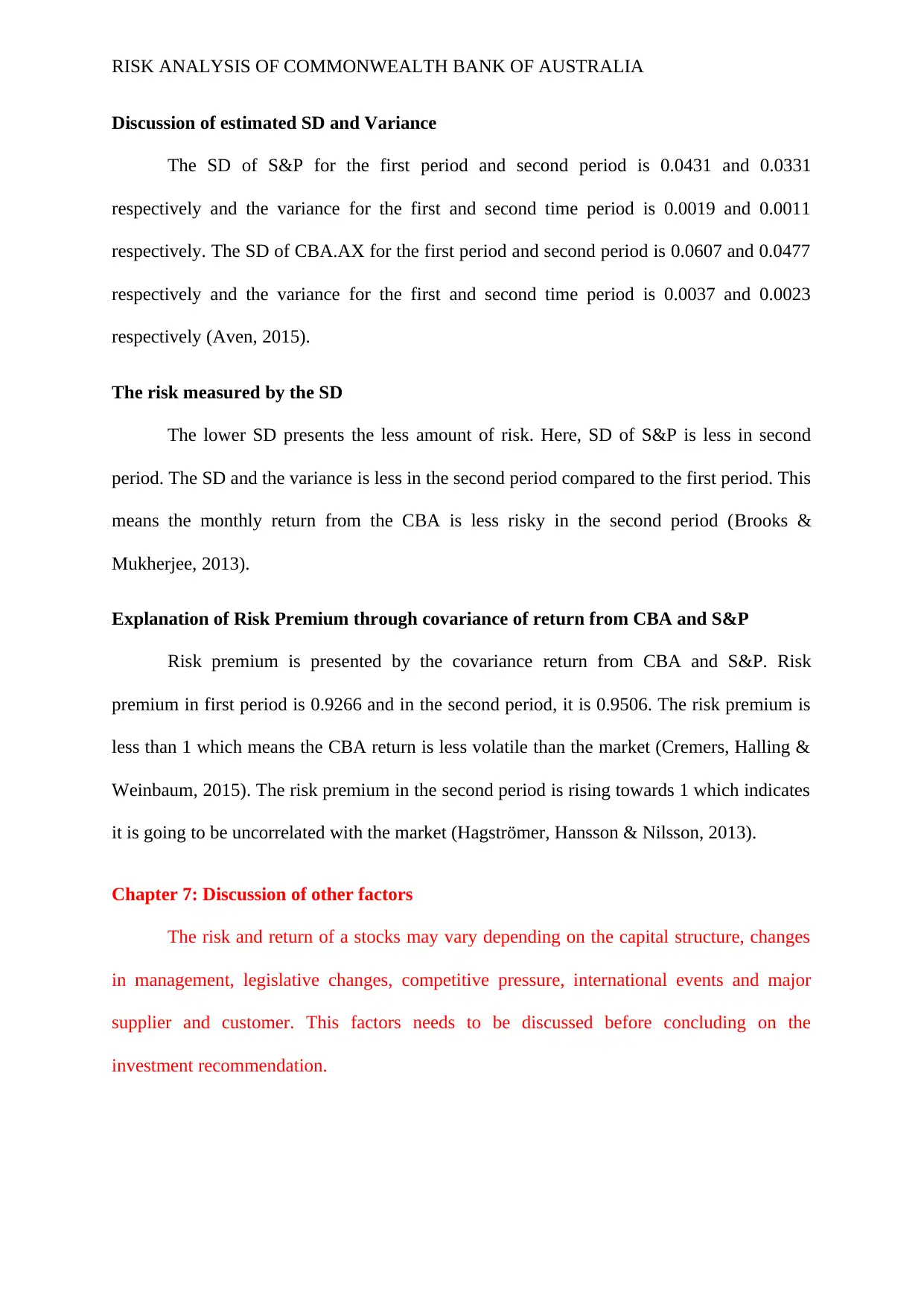
RISK ANALYSIS OF COMMONWEALTH BANK OF AUSTRALIA
Discussion of estimated SD and Variance
The SD of S&P for the first period and second period is 0.0431 and 0.0331
respectively and the variance for the first and second time period is 0.0019 and 0.0011
respectively. The SD of CBA.AX for the first period and second period is 0.0607 and 0.0477
respectively and the variance for the first and second time period is 0.0037 and 0.0023
respectively (Aven, 2015).
The risk measured by the SD
The lower SD presents the less amount of risk. Here, SD of S&P is less in second
period. The SD and the variance is less in the second period compared to the first period. This
means the monthly return from the CBA is less risky in the second period (Brooks &
Mukherjee, 2013).
Explanation of Risk Premium through covariance of return from CBA and S&P
Risk premium is presented by the covariance return from CBA and S&P. Risk
premium in first period is 0.9266 and in the second period, it is 0.9506. The risk premium is
less than 1 which means the CBA return is less volatile than the market (Cremers, Halling &
Weinbaum, 2015). The risk premium in the second period is rising towards 1 which indicates
it is going to be uncorrelated with the market (Hagströmer, Hansson & Nilsson, 2013).
Chapter 7: Discussion of other factors
The risk and return of a stocks may vary depending on the capital structure, changes
in management, legislative changes, competitive pressure, international events and major
supplier and customer. This factors needs to be discussed before concluding on the
investment recommendation.
Discussion of estimated SD and Variance
The SD of S&P for the first period and second period is 0.0431 and 0.0331
respectively and the variance for the first and second time period is 0.0019 and 0.0011
respectively. The SD of CBA.AX for the first period and second period is 0.0607 and 0.0477
respectively and the variance for the first and second time period is 0.0037 and 0.0023
respectively (Aven, 2015).
The risk measured by the SD
The lower SD presents the less amount of risk. Here, SD of S&P is less in second
period. The SD and the variance is less in the second period compared to the first period. This
means the monthly return from the CBA is less risky in the second period (Brooks &
Mukherjee, 2013).
Explanation of Risk Premium through covariance of return from CBA and S&P
Risk premium is presented by the covariance return from CBA and S&P. Risk
premium in first period is 0.9266 and in the second period, it is 0.9506. The risk premium is
less than 1 which means the CBA return is less volatile than the market (Cremers, Halling &
Weinbaum, 2015). The risk premium in the second period is rising towards 1 which indicates
it is going to be uncorrelated with the market (Hagströmer, Hansson & Nilsson, 2013).
Chapter 7: Discussion of other factors
The risk and return of a stocks may vary depending on the capital structure, changes
in management, legislative changes, competitive pressure, international events and major
supplier and customer. This factors needs to be discussed before concluding on the
investment recommendation.
Secure Best Marks with AI Grader
Need help grading? Try our AI Grader for instant feedback on your assignments.
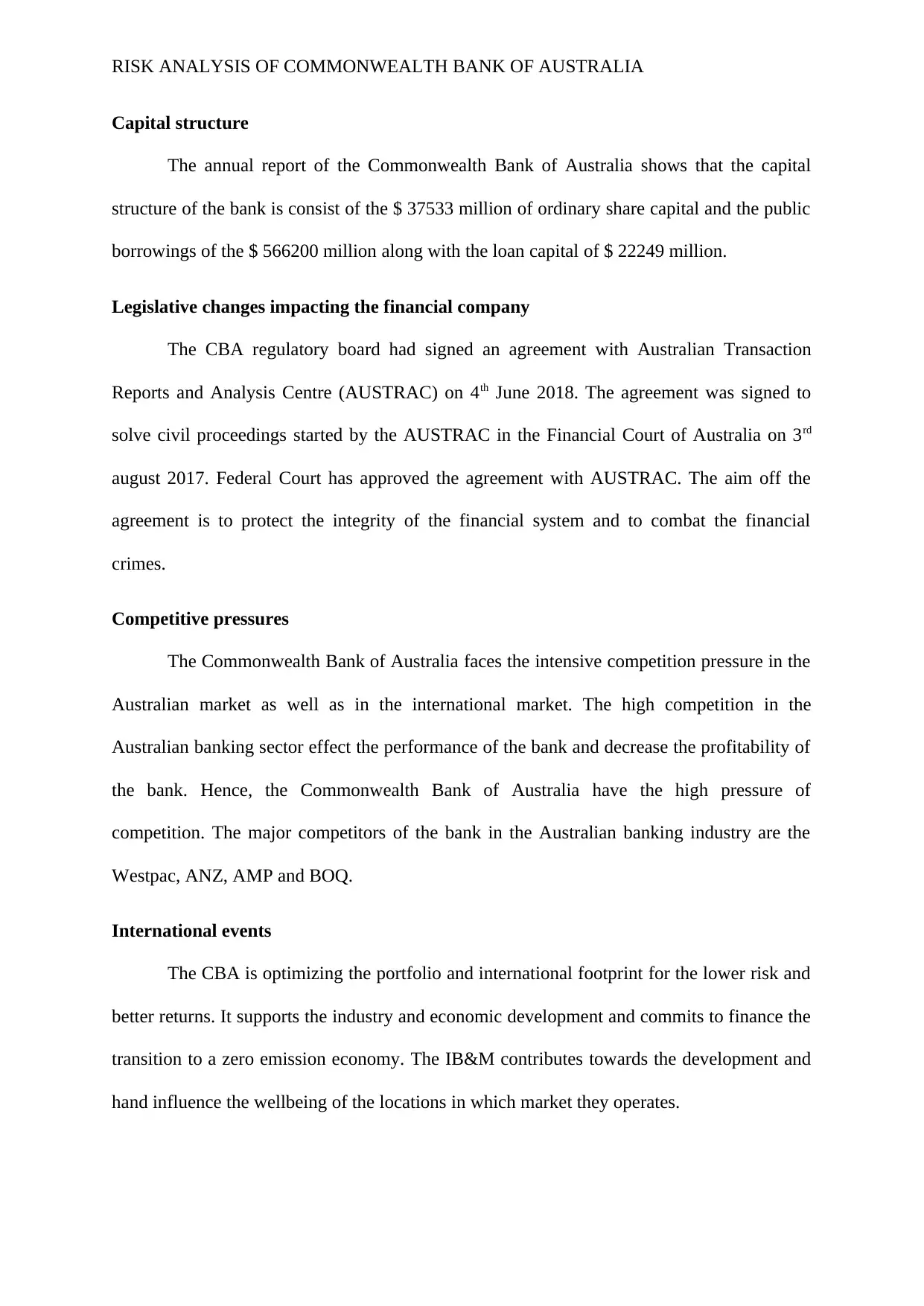
RISK ANALYSIS OF COMMONWEALTH BANK OF AUSTRALIA
Capital structure
The annual report of the Commonwealth Bank of Australia shows that the capital
structure of the bank is consist of the $ 37533 million of ordinary share capital and the public
borrowings of the $ 566200 million along with the loan capital of $ 22249 million.
Legislative changes impacting the financial company
The CBA regulatory board had signed an agreement with Australian Transaction
Reports and Analysis Centre (AUSTRAC) on 4th June 2018. The agreement was signed to
solve civil proceedings started by the AUSTRAC in the Financial Court of Australia on 3rd
august 2017. Federal Court has approved the agreement with AUSTRAC. The aim off the
agreement is to protect the integrity of the financial system and to combat the financial
crimes.
Competitive pressures
The Commonwealth Bank of Australia faces the intensive competition pressure in the
Australian market as well as in the international market. The high competition in the
Australian banking sector effect the performance of the bank and decrease the profitability of
the bank. Hence, the Commonwealth Bank of Australia have the high pressure of
competition. The major competitors of the bank in the Australian banking industry are the
Westpac, ANZ, AMP and BOQ.
International events
The CBA is optimizing the portfolio and international footprint for the lower risk and
better returns. It supports the industry and economic development and commits to finance the
transition to a zero emission economy. The IB&M contributes towards the development and
hand influence the wellbeing of the locations in which market they operates.
Capital structure
The annual report of the Commonwealth Bank of Australia shows that the capital
structure of the bank is consist of the $ 37533 million of ordinary share capital and the public
borrowings of the $ 566200 million along with the loan capital of $ 22249 million.
Legislative changes impacting the financial company
The CBA regulatory board had signed an agreement with Australian Transaction
Reports and Analysis Centre (AUSTRAC) on 4th June 2018. The agreement was signed to
solve civil proceedings started by the AUSTRAC in the Financial Court of Australia on 3rd
august 2017. Federal Court has approved the agreement with AUSTRAC. The aim off the
agreement is to protect the integrity of the financial system and to combat the financial
crimes.
Competitive pressures
The Commonwealth Bank of Australia faces the intensive competition pressure in the
Australian market as well as in the international market. The high competition in the
Australian banking sector effect the performance of the bank and decrease the profitability of
the bank. Hence, the Commonwealth Bank of Australia have the high pressure of
competition. The major competitors of the bank in the Australian banking industry are the
Westpac, ANZ, AMP and BOQ.
International events
The CBA is optimizing the portfolio and international footprint for the lower risk and
better returns. It supports the industry and economic development and commits to finance the
transition to a zero emission economy. The IB&M contributes towards the development and
hand influence the wellbeing of the locations in which market they operates.
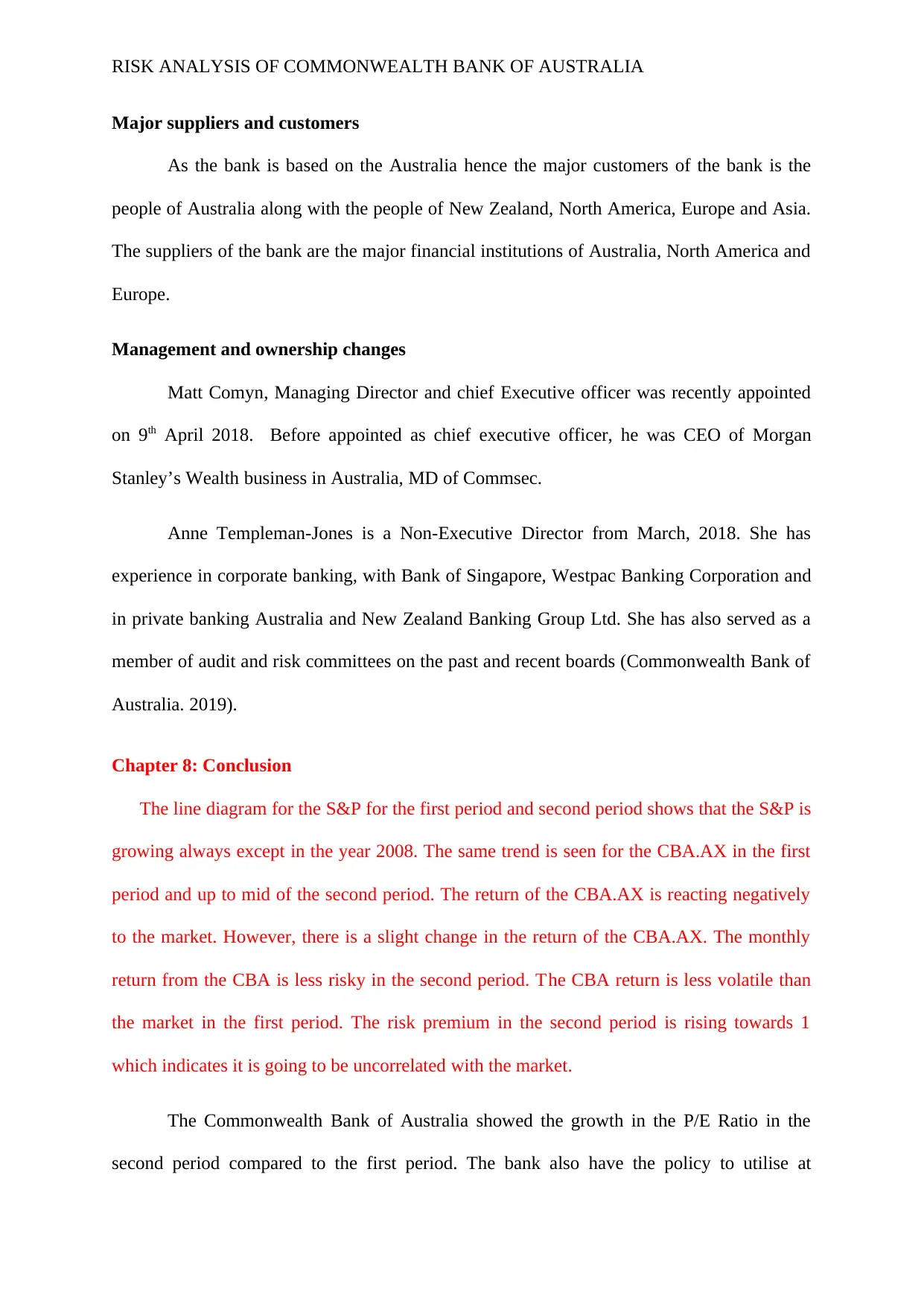
RISK ANALYSIS OF COMMONWEALTH BANK OF AUSTRALIA
Major suppliers and customers
As the bank is based on the Australia hence the major customers of the bank is the
people of Australia along with the people of New Zealand, North America, Europe and Asia.
The suppliers of the bank are the major financial institutions of Australia, North America and
Europe.
Management and ownership changes
Matt Comyn, Managing Director and chief Executive officer was recently appointed
on 9th April 2018. Before appointed as chief executive officer, he was CEO of Morgan
Stanley’s Wealth business in Australia, MD of Commsec.
Anne Templeman-Jones is a Non-Executive Director from March, 2018. She has
experience in corporate banking, with Bank of Singapore, Westpac Banking Corporation and
in private banking Australia and New Zealand Banking Group Ltd. She has also served as a
member of audit and risk committees on the past and recent boards (Commonwealth Bank of
Australia. 2019).
Chapter 8: Conclusion
The line diagram for the S&P for the first period and second period shows that the S&P is
growing always except in the year 2008. The same trend is seen for the CBA.AX in the first
period and up to mid of the second period. The return of the CBA.AX is reacting negatively
to the market. However, there is a slight change in the return of the CBA.AX. The monthly
return from the CBA is less risky in the second period. The CBA return is less volatile than
the market in the first period. The risk premium in the second period is rising towards 1
which indicates it is going to be uncorrelated with the market.
The Commonwealth Bank of Australia showed the growth in the P/E Ratio in the
second period compared to the first period. The bank also have the policy to utilise at
Major suppliers and customers
As the bank is based on the Australia hence the major customers of the bank is the
people of Australia along with the people of New Zealand, North America, Europe and Asia.
The suppliers of the bank are the major financial institutions of Australia, North America and
Europe.
Management and ownership changes
Matt Comyn, Managing Director and chief Executive officer was recently appointed
on 9th April 2018. Before appointed as chief executive officer, he was CEO of Morgan
Stanley’s Wealth business in Australia, MD of Commsec.
Anne Templeman-Jones is a Non-Executive Director from March, 2018. She has
experience in corporate banking, with Bank of Singapore, Westpac Banking Corporation and
in private banking Australia and New Zealand Banking Group Ltd. She has also served as a
member of audit and risk committees on the past and recent boards (Commonwealth Bank of
Australia. 2019).
Chapter 8: Conclusion
The line diagram for the S&P for the first period and second period shows that the S&P is
growing always except in the year 2008. The same trend is seen for the CBA.AX in the first
period and up to mid of the second period. The return of the CBA.AX is reacting negatively
to the market. However, there is a slight change in the return of the CBA.AX. The monthly
return from the CBA is less risky in the second period. The CBA return is less volatile than
the market in the first period. The risk premium in the second period is rising towards 1
which indicates it is going to be uncorrelated with the market.
The Commonwealth Bank of Australia showed the growth in the P/E Ratio in the
second period compared to the first period. The bank also have the policy to utilise at
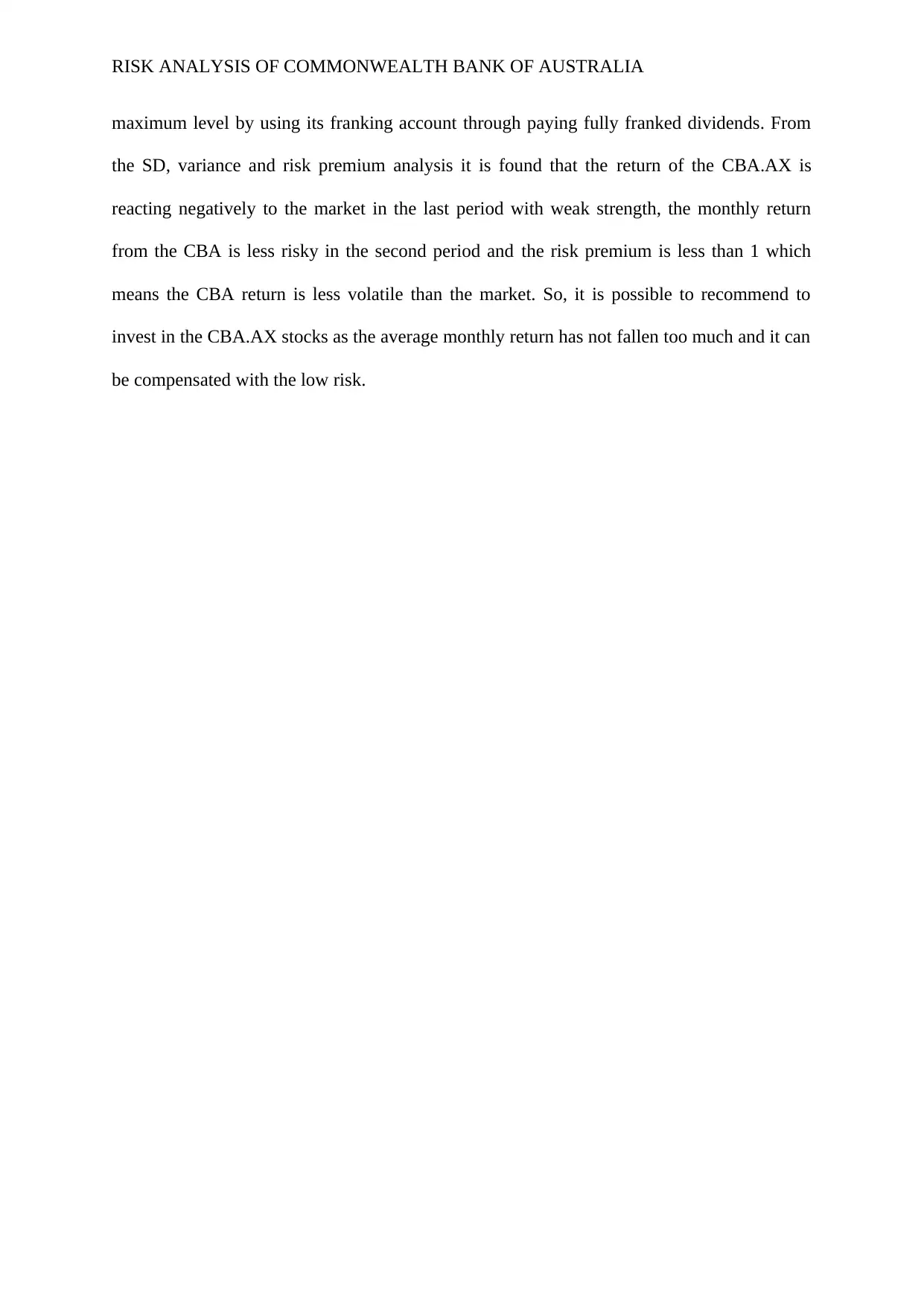
RISK ANALYSIS OF COMMONWEALTH BANK OF AUSTRALIA
maximum level by using its franking account through paying fully franked dividends. From
the SD, variance and risk premium analysis it is found that the return of the CBA.AX is
reacting negatively to the market in the last period with weak strength, the monthly return
from the CBA is less risky in the second period and the risk premium is less than 1 which
means the CBA return is less volatile than the market. So, it is possible to recommend to
invest in the CBA.AX stocks as the average monthly return has not fallen too much and it can
be compensated with the low risk.
maximum level by using its franking account through paying fully franked dividends. From
the SD, variance and risk premium analysis it is found that the return of the CBA.AX is
reacting negatively to the market in the last period with weak strength, the monthly return
from the CBA is less risky in the second period and the risk premium is less than 1 which
means the CBA return is less volatile than the market. So, it is possible to recommend to
invest in the CBA.AX stocks as the average monthly return has not fallen too much and it can
be compensated with the low risk.
Paraphrase This Document
Need a fresh take? Get an instant paraphrase of this document with our AI Paraphraser
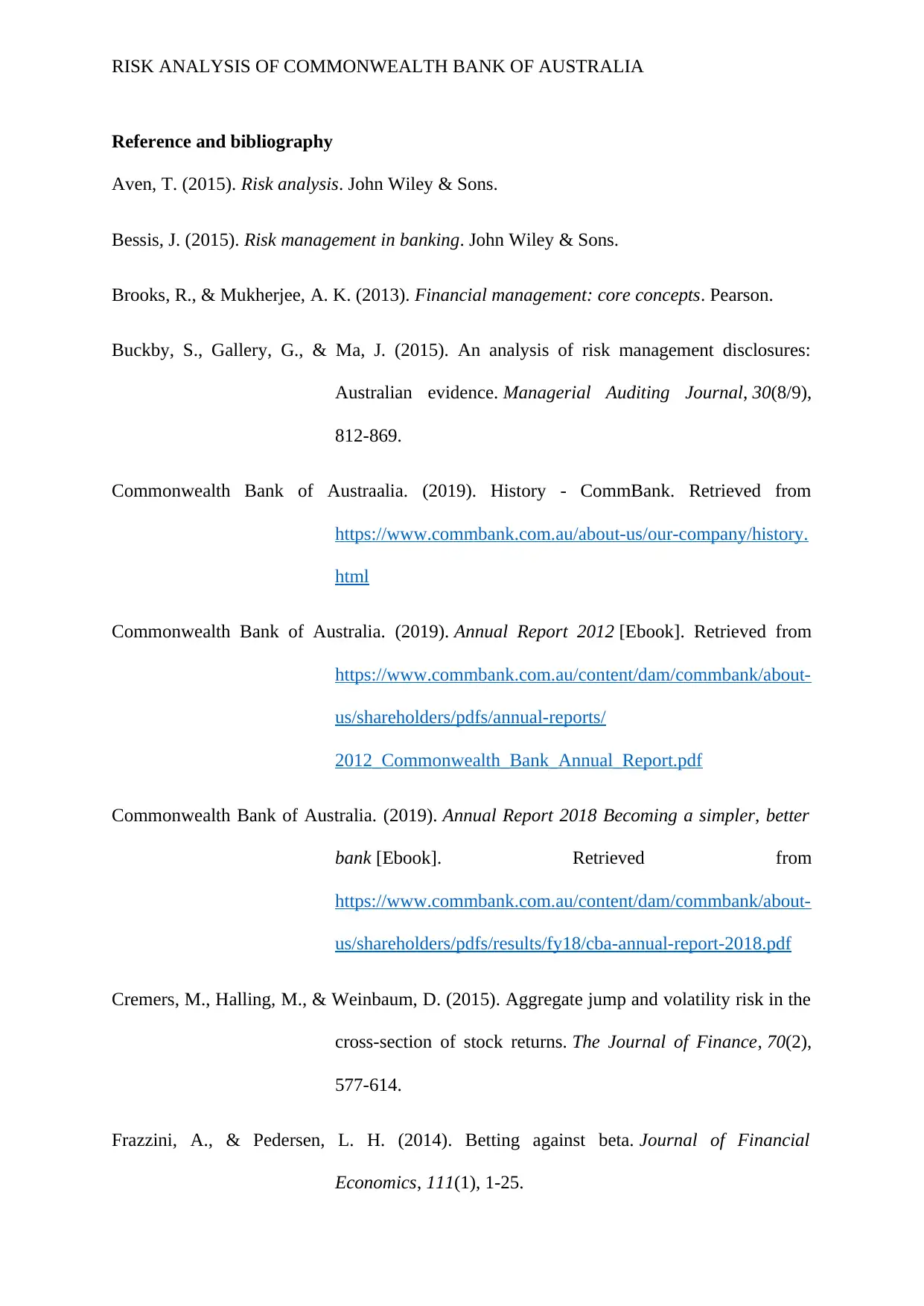
RISK ANALYSIS OF COMMONWEALTH BANK OF AUSTRALIA
Reference and bibliography
Aven, T. (2015). Risk analysis. John Wiley & Sons.
Bessis, J. (2015). Risk management in banking. John Wiley & Sons.
Brooks, R., & Mukherjee, A. K. (2013). Financial management: core concepts. Pearson.
Buckby, S., Gallery, G., & Ma, J. (2015). An analysis of risk management disclosures:
Australian evidence. Managerial Auditing Journal, 30(8/9),
812-869.
Commonwealth Bank of Austraalia. (2019). History - CommBank. Retrieved from
https://www.commbank.com.au/about-us/our-company/history.
html
Commonwealth Bank of Australia. (2019). Annual Report 2012 [Ebook]. Retrieved from
https://www.commbank.com.au/content/dam/commbank/about-
us/shareholders/pdfs/annual-reports/
2012_Commonwealth_Bank_Annual_Report.pdf
Commonwealth Bank of Australia. (2019). Annual Report 2018 Becoming a simpler, better
bank [Ebook]. Retrieved from
https://www.commbank.com.au/content/dam/commbank/about-
us/shareholders/pdfs/results/fy18/cba-annual-report-2018.pdf
Cremers, M., Halling, M., & Weinbaum, D. (2015). Aggregate jump and volatility risk in the
cross‐section of stock returns. The Journal of Finance, 70(2),
577-614.
Frazzini, A., & Pedersen, L. H. (2014). Betting against beta. Journal of Financial
Economics, 111(1), 1-25.
Reference and bibliography
Aven, T. (2015). Risk analysis. John Wiley & Sons.
Bessis, J. (2015). Risk management in banking. John Wiley & Sons.
Brooks, R., & Mukherjee, A. K. (2013). Financial management: core concepts. Pearson.
Buckby, S., Gallery, G., & Ma, J. (2015). An analysis of risk management disclosures:
Australian evidence. Managerial Auditing Journal, 30(8/9),
812-869.
Commonwealth Bank of Austraalia. (2019). History - CommBank. Retrieved from
https://www.commbank.com.au/about-us/our-company/history.
html
Commonwealth Bank of Australia. (2019). Annual Report 2012 [Ebook]. Retrieved from
https://www.commbank.com.au/content/dam/commbank/about-
us/shareholders/pdfs/annual-reports/
2012_Commonwealth_Bank_Annual_Report.pdf
Commonwealth Bank of Australia. (2019). Annual Report 2018 Becoming a simpler, better
bank [Ebook]. Retrieved from
https://www.commbank.com.au/content/dam/commbank/about-
us/shareholders/pdfs/results/fy18/cba-annual-report-2018.pdf
Cremers, M., Halling, M., & Weinbaum, D. (2015). Aggregate jump and volatility risk in the
cross‐section of stock returns. The Journal of Finance, 70(2),
577-614.
Frazzini, A., & Pedersen, L. H. (2014). Betting against beta. Journal of Financial
Economics, 111(1), 1-25.
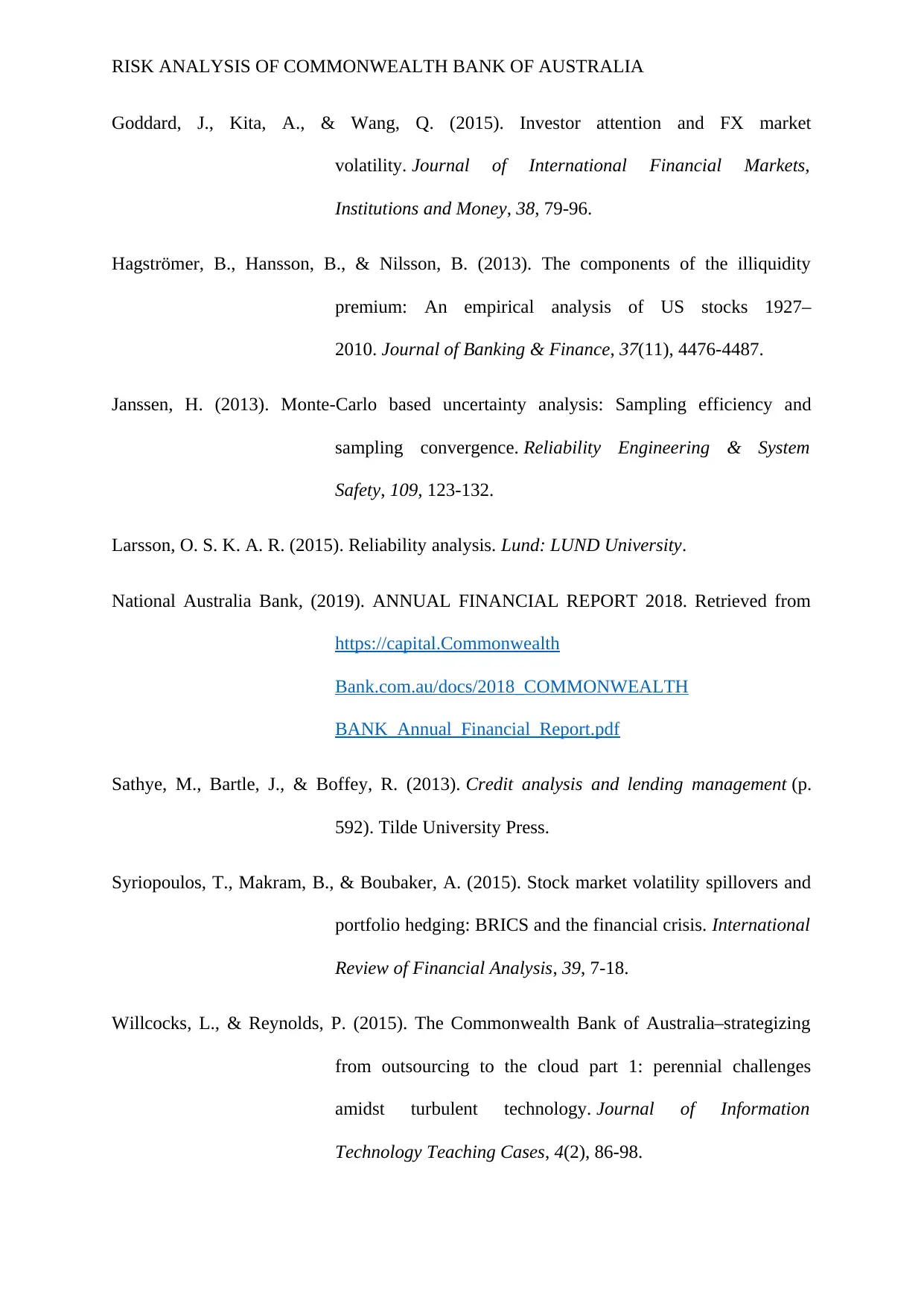
RISK ANALYSIS OF COMMONWEALTH BANK OF AUSTRALIA
Goddard, J., Kita, A., & Wang, Q. (2015). Investor attention and FX market
volatility. Journal of International Financial Markets,
Institutions and Money, 38, 79-96.
Hagströmer, B., Hansson, B., & Nilsson, B. (2013). The components of the illiquidity
premium: An empirical analysis of US stocks 1927–
2010. Journal of Banking & Finance, 37(11), 4476-4487.
Janssen, H. (2013). Monte-Carlo based uncertainty analysis: Sampling efficiency and
sampling convergence. Reliability Engineering & System
Safety, 109, 123-132.
Larsson, O. S. K. A. R. (2015). Reliability analysis. Lund: LUND University.
National Australia Bank, (2019). ANNUAL FINANCIAL REPORT 2018. Retrieved from
https://capital.Commonwealth
Bank.com.au/docs/2018_COMMONWEALTH
BANK_Annual_Financial_Report.pdf
Sathye, M., Bartle, J., & Boffey, R. (2013). Credit analysis and lending management (p.
592). Tilde University Press.
Syriopoulos, T., Makram, B., & Boubaker, A. (2015). Stock market volatility spillovers and
portfolio hedging: BRICS and the financial crisis. International
Review of Financial Analysis, 39, 7-18.
Willcocks, L., & Reynolds, P. (2015). The Commonwealth Bank of Australia–strategizing
from outsourcing to the cloud part 1: perennial challenges
amidst turbulent technology. Journal of Information
Technology Teaching Cases, 4(2), 86-98.
Goddard, J., Kita, A., & Wang, Q. (2015). Investor attention and FX market
volatility. Journal of International Financial Markets,
Institutions and Money, 38, 79-96.
Hagströmer, B., Hansson, B., & Nilsson, B. (2013). The components of the illiquidity
premium: An empirical analysis of US stocks 1927–
2010. Journal of Banking & Finance, 37(11), 4476-4487.
Janssen, H. (2013). Monte-Carlo based uncertainty analysis: Sampling efficiency and
sampling convergence. Reliability Engineering & System
Safety, 109, 123-132.
Larsson, O. S. K. A. R. (2015). Reliability analysis. Lund: LUND University.
National Australia Bank, (2019). ANNUAL FINANCIAL REPORT 2018. Retrieved from
https://capital.Commonwealth
Bank.com.au/docs/2018_COMMONWEALTH
BANK_Annual_Financial_Report.pdf
Sathye, M., Bartle, J., & Boffey, R. (2013). Credit analysis and lending management (p.
592). Tilde University Press.
Syriopoulos, T., Makram, B., & Boubaker, A. (2015). Stock market volatility spillovers and
portfolio hedging: BRICS and the financial crisis. International
Review of Financial Analysis, 39, 7-18.
Willcocks, L., & Reynolds, P. (2015). The Commonwealth Bank of Australia–strategizing
from outsourcing to the cloud part 1: perennial challenges
amidst turbulent technology. Journal of Information
Technology Teaching Cases, 4(2), 86-98.

RISK ANALYSIS OF COMMONWEALTH BANK OF AUSTRALIA
Yahoo is now a part of Oath. (2019). Retrieved from
https://au.finance.yahoo.com/quote/COMMONWEALTH
BANK.AX/history/
Yahoo is now a part of Oath. (2019). Retrieved from
https://au.finance.yahoo.com/quote/COMMONWEALTH
BANK.AX/history/
1 out of 22
Related Documents
Your All-in-One AI-Powered Toolkit for Academic Success.
+13062052269
info@desklib.com
Available 24*7 on WhatsApp / Email
![[object Object]](/_next/static/media/star-bottom.7253800d.svg)
Unlock your academic potential
© 2024 | Zucol Services PVT LTD | All rights reserved.





